-
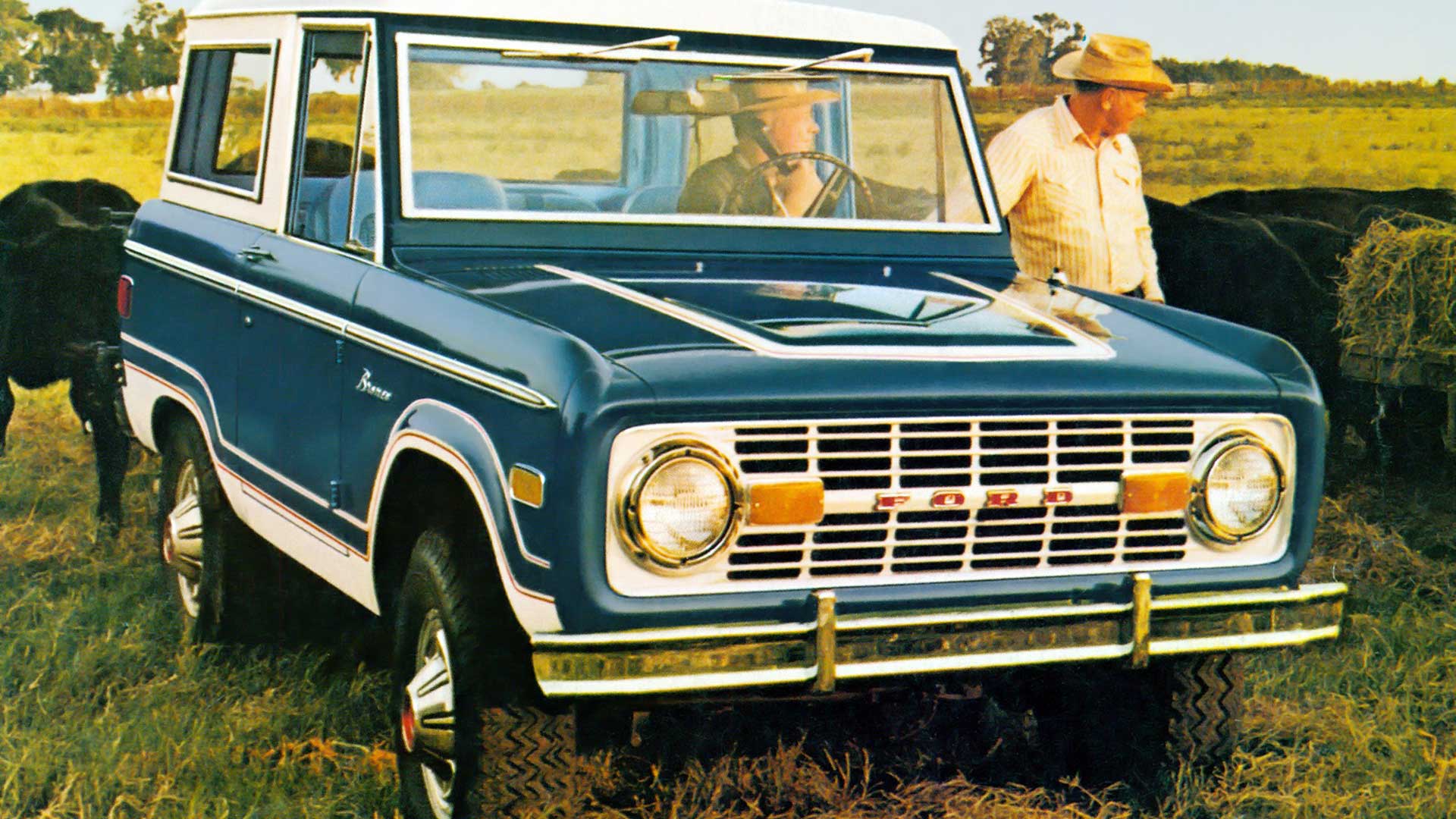
The continuing legend of the Ford Bronco
© Ford‘Bronco fever’ feels like it might never go away, with fans still flocking to Ford’s reborn SUV. The Blue Oval continues to update the retro-inspired off-roader, with the 2022 model gaining the performance Raptor version, and Everglades special edition.
The Bronco has embedded itself in American culture, its lineage stretching back to the 1960s. Having featured in more than 1,200 movies and 200 songs, calling Ford’s original SUV an icon is no exaggeration.
Read on for the complete story of the Ford Bronco.
-
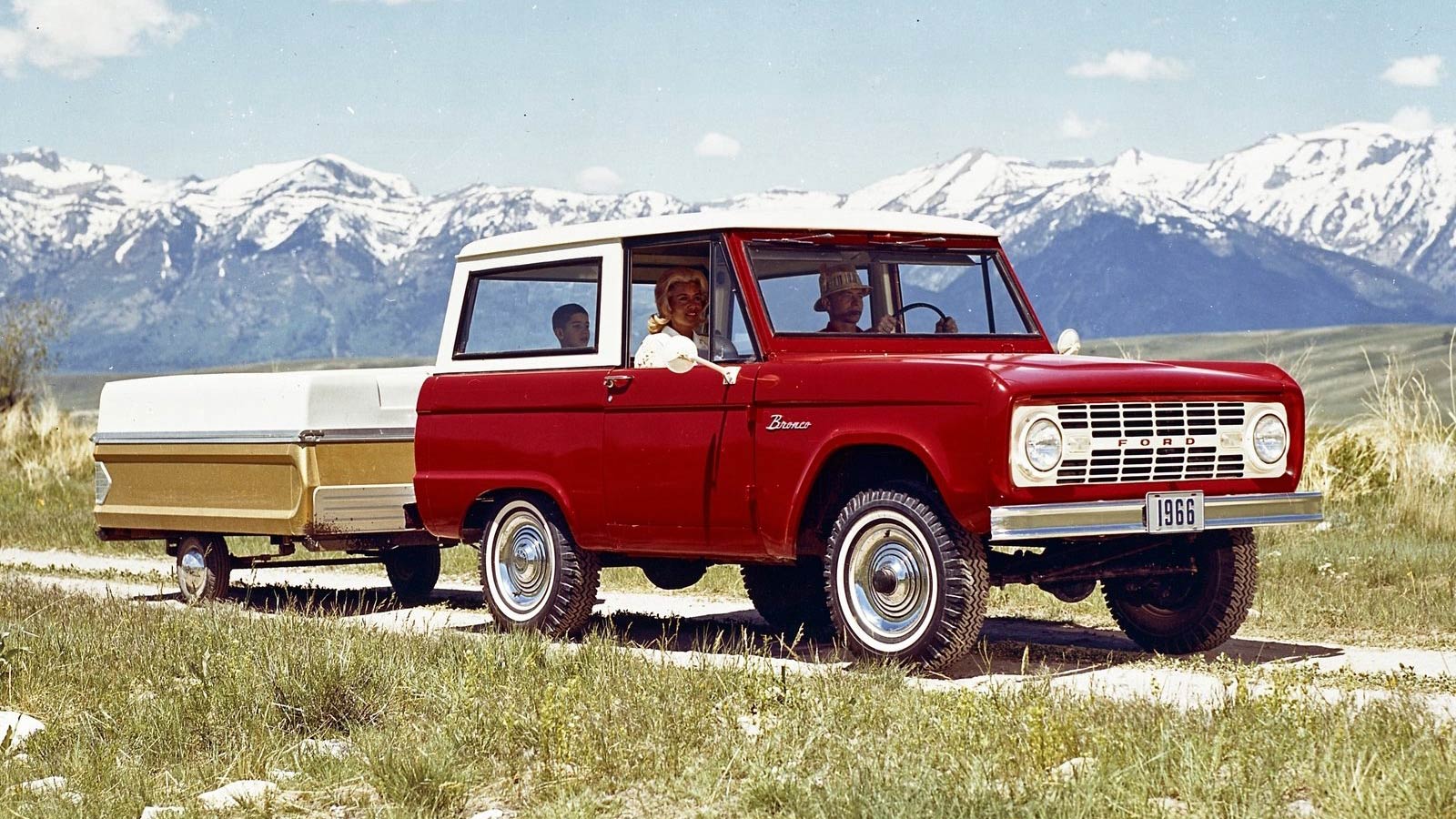
1966 Ford Bronco SUV
© FordThe creation of the Ford Bronco is intrinsically linked to another American icon – the Mustang. Both were championed by Ford vice-president Donald Frey, who wanted the Bronco to offer Mustang-style thrills for the off-road market.
Launched for the 1966 model year, the original Bronco offered body-on-frame construction with high ground clearance and a short wheelbase. All versions would come with four-wheel drive, locking hubs, and coil springs for the front suspension.
-
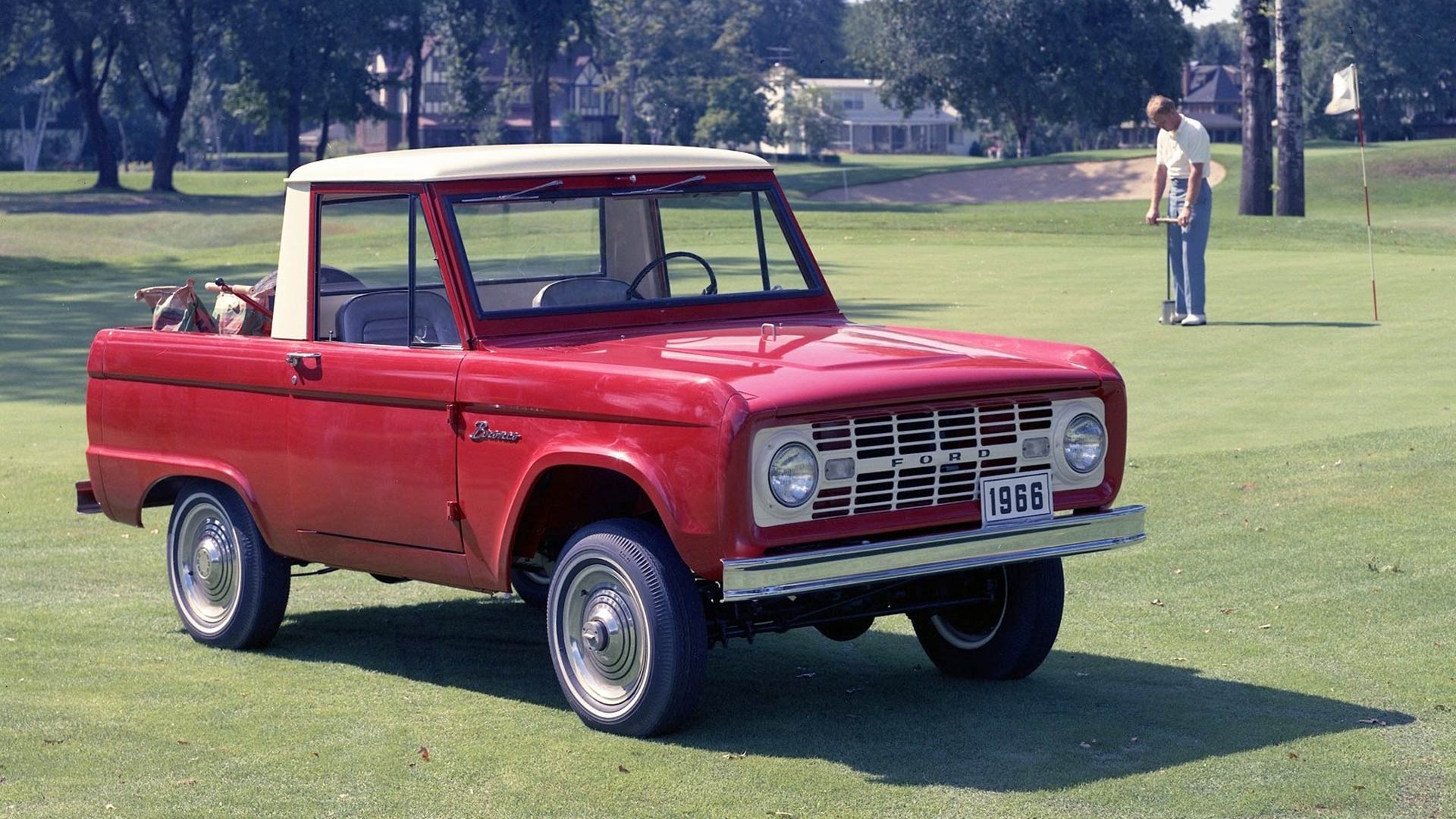
1966 Ford Bronco Pickup
© FordAt launch, the Bronco was available solely with a 170-cubic inch six-cylinder gasoline engine. Found in other Ford products, this engine was proven to deliver reliability, even if 105 horsepower would hardly set the world alight.
Later in the first model year, Ford would add the 289-cubic inch V-8 engine to the options list. With 200 horsepower, it helped boost the Bronco’s performance.
Both engines came with a three-speed manual transmission, using a column-mounted shifter.
-
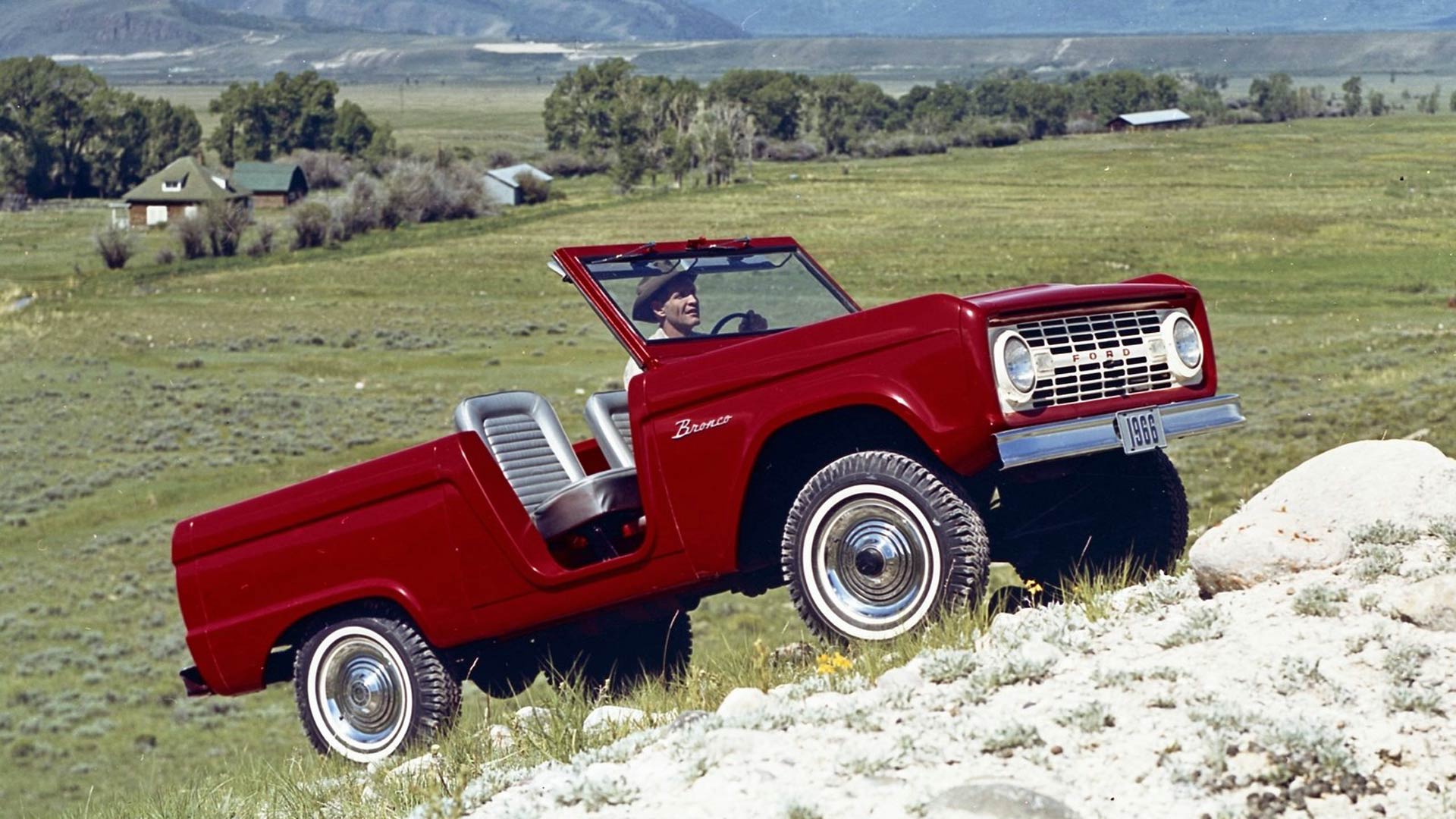
1966 Ford Bronco Roadster
© FordOne of the standout features of the original Bronco was the choice of three different body styles. Along with the conventional SUV and pickup options, the open-top Bronco Roadster would be the rarest of the trio.
Pitched to beachgoers as an alternative to a dune buggy, the Bronco Roadster came with silver vinyl seats as standard. With no doors or roof, the Roadster’s appeal would be limited to those in sunnier states.
It explains why only 5,000 were sold, before the Roadster was dropped in 1968.
-
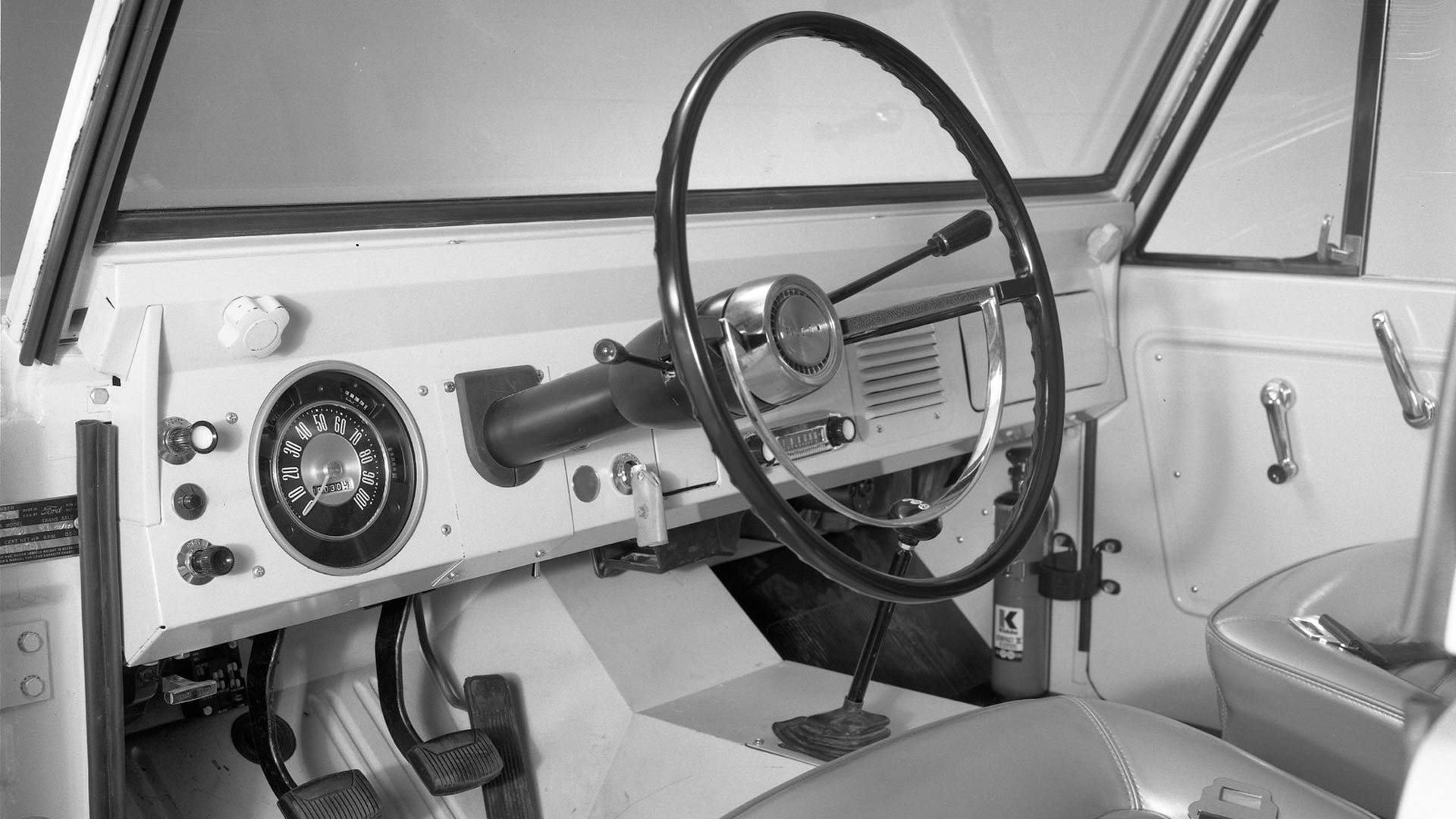
1966 Ford Bronco Interior
© FordWith a relatively low starting price of under $2,200, Ford had to ensure the Bronco’s design maximized utility and simplicity. This included the use of flat glass for the windows, along with simple C-profile bumpers.
The interior itself was spartan, but Ford offered plenty of options for buyers to add. These included a CB radio and tachometer, along with front bucket seats. A snow plow could also be found on the options list for those wanting to be ready for winter.
All of this helped the Bronco be a success for the first year of production, with 24,000 vehicles sold.
-
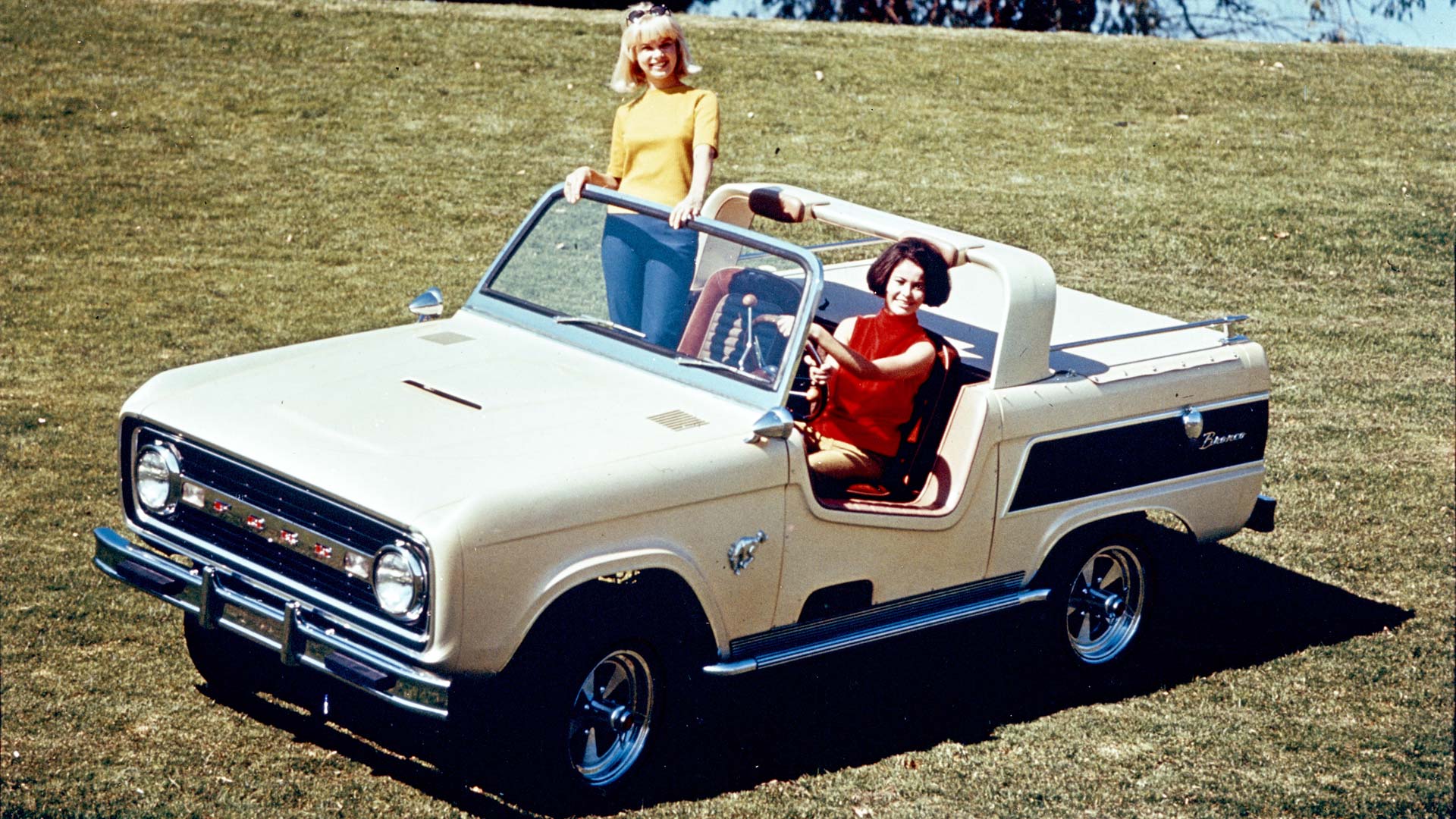
1966 Ford Bronco Dune Duster Concept
© FordDespite the Bronco already being a hit, Ford wasted no time in displaying a modified version at the 1966 Chicago Auto Show.
Built by the famed Barris Kustoms, the Dune Duster Concept resembled the Bronco Roadster, but with an NHRA-approved roll bar added. Barris also installed an exposed chrome exhaust system, extra hood scoop, and alloy hubs.
On the inside, walnut wood accents were used throughout, with suede upholstery.
-
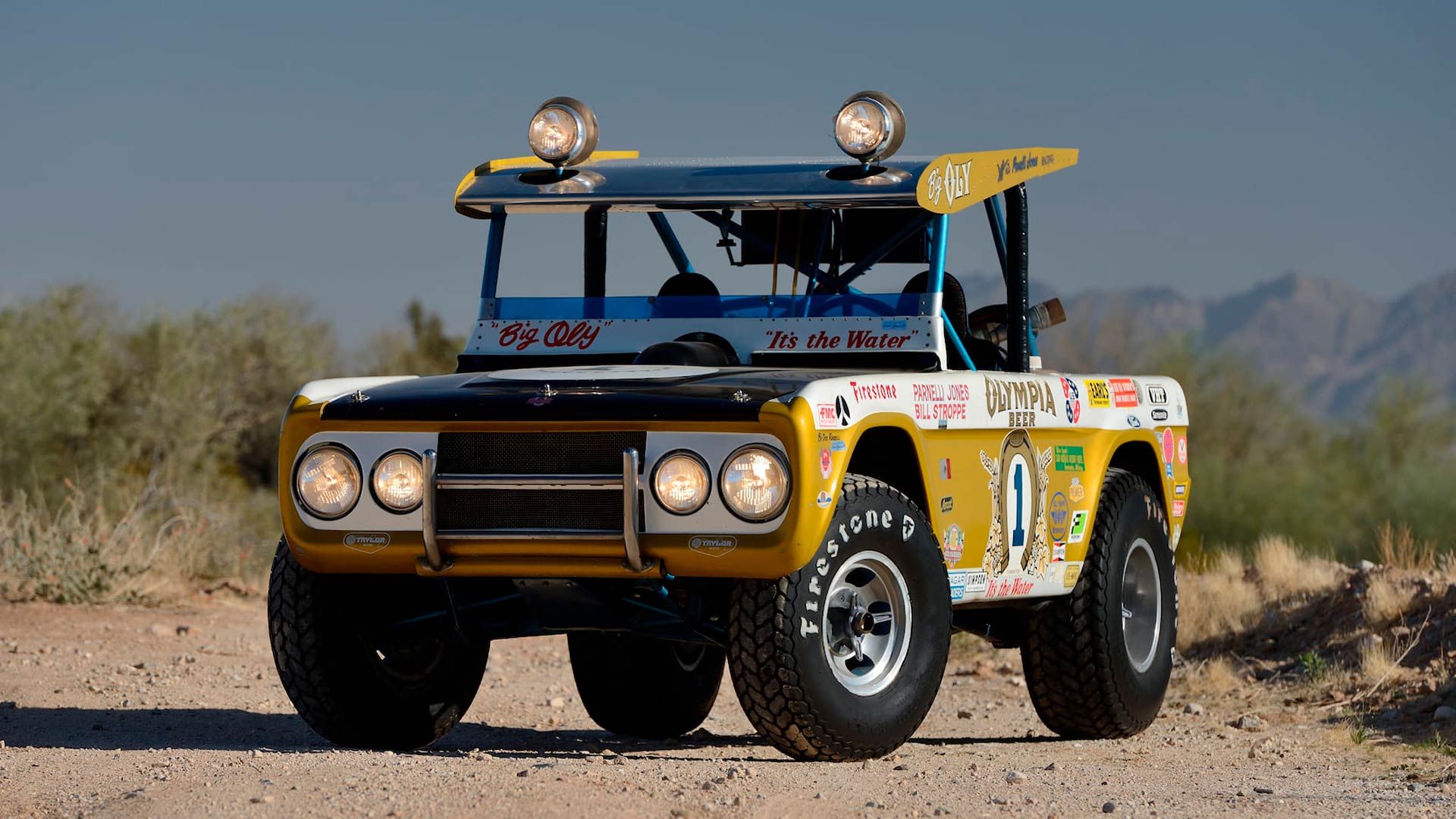
1969 Ford Bronco Big Oly
© FordArguably the world’s most-famous Ford Bronco, “Big Oly” was built by Bill Stroppe to be driven by Parnelli Jones. A lightweight tube-frame chassis, fiberglass body panels, and a 351-cubic inch V-8 produced a prodigious off-road racer.
Sponsored by the Olympia Brewing company, Big Oly would take Jones and Stroppe to multiple off-road wins. This included the 1971 Baja 1000, 1972 Baja 1000, 1973 Baja 500 and 1973 Mint 400.
Big Oly was auctioned at the Mecum Auctions Indy 2021 sale, along with a range of other vehicles owned by Parnelli Jones. On the block it achieved an incredible $1.87 million.
-
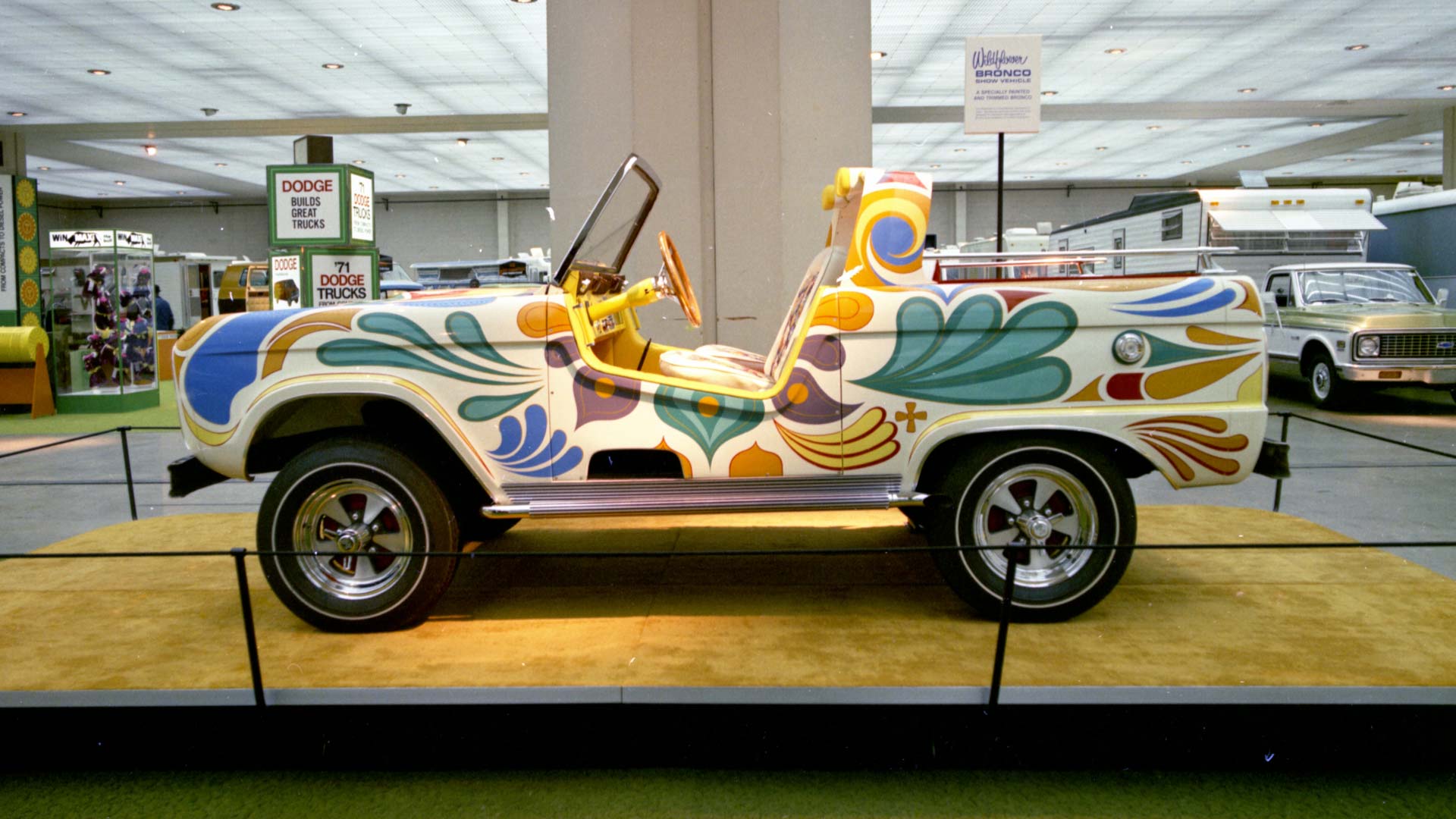
1970 Ford Bronco Wildflower Concept
© FordSeveral years after displaying the Bronco Dune Duster Concept, Ford modified the base vehicle to create the colorful Wildflower Concept. The exterior design was the most obvious difference, with a psychedelic array of yellow, blue, and green petals.
Ford did not leave the interior untouched. It applied the same pattern found on the outside to cover patterned inserts for the seats.
-
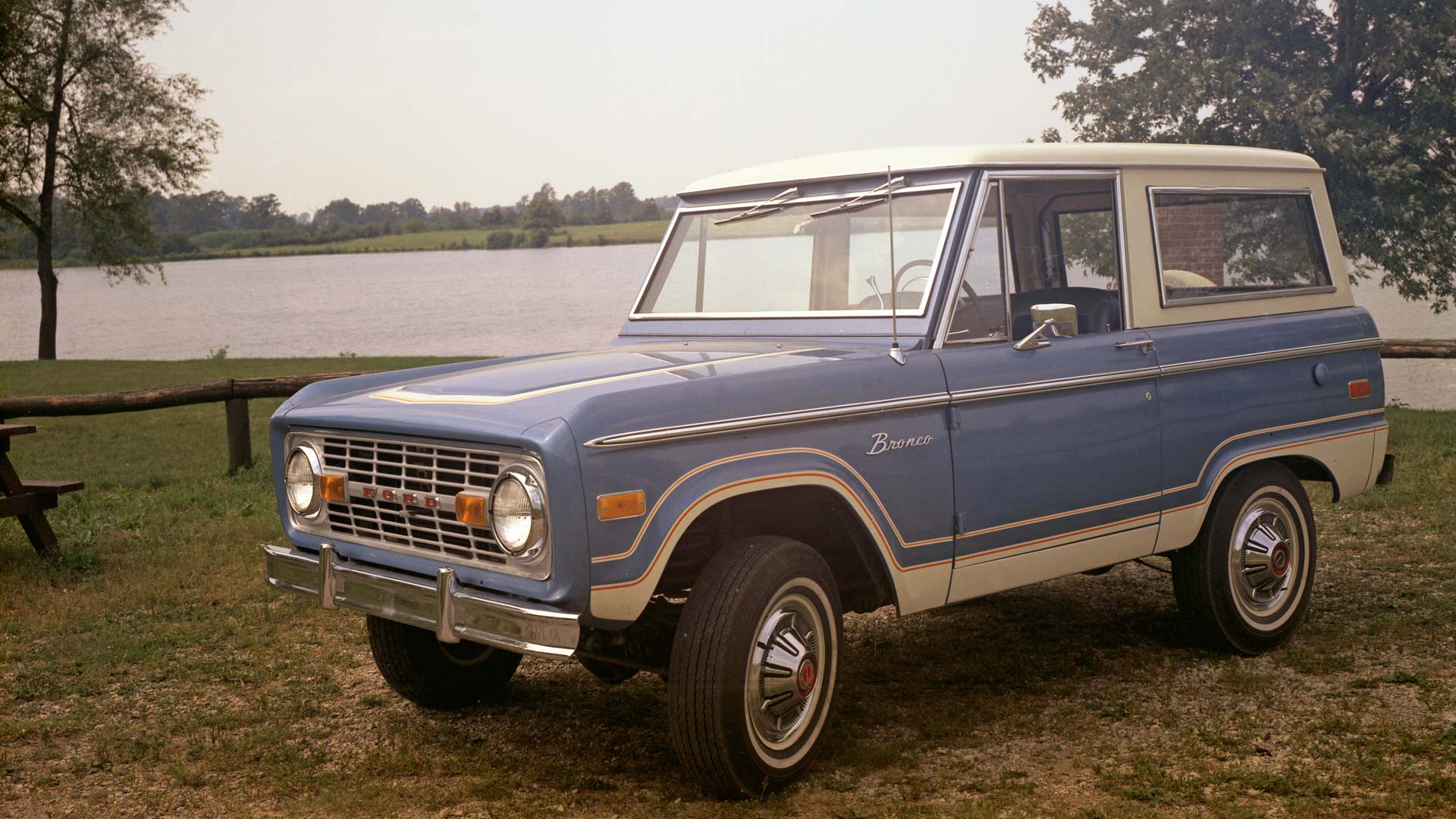
1973 Ford Bronco
© FordDespite the initial success of the Bronco, Ford continued to update and evolve its SUV to keep it competitive. After dropping the Roadster in 1968, Ford also ditched the pickup model by 1972.
Other changes had seen the introduction of a more powerful 302-cubic inch V-8 in 1969. To keep pace with rivals, the standard six-cylinder engine grew in size to become a 200-cubic inch unit for 1973.
Pressure from rivals made Ford introduce an updated four-speed automatic transmission. All of this helped sell more than 21,000 examples of the Bronco during 1973.
-
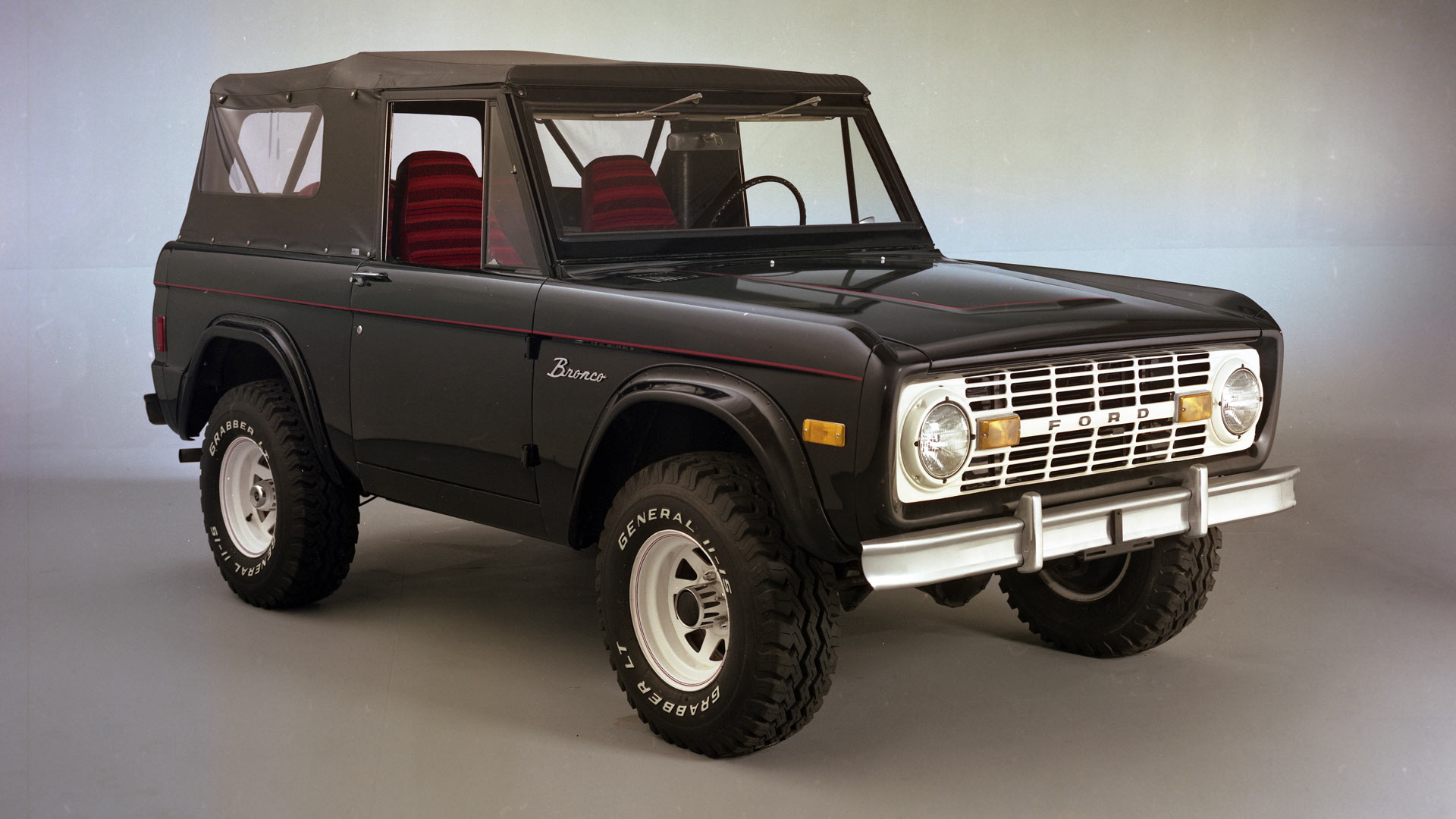
1977 Ford Bronco
© FordAfter more than a decade in production, the first-generation Bronco was starting to show its age. Newer, and larger, rivals like the Dodge Ramcharger and Chevrolet K5 Blazer showed the direction of the SUV market.
Despite the original Bronco reaching the end of its lifespan, Ford still sold more than 14,000 examples in 1977. This took total production for the first-generation model to over 220,000.
-
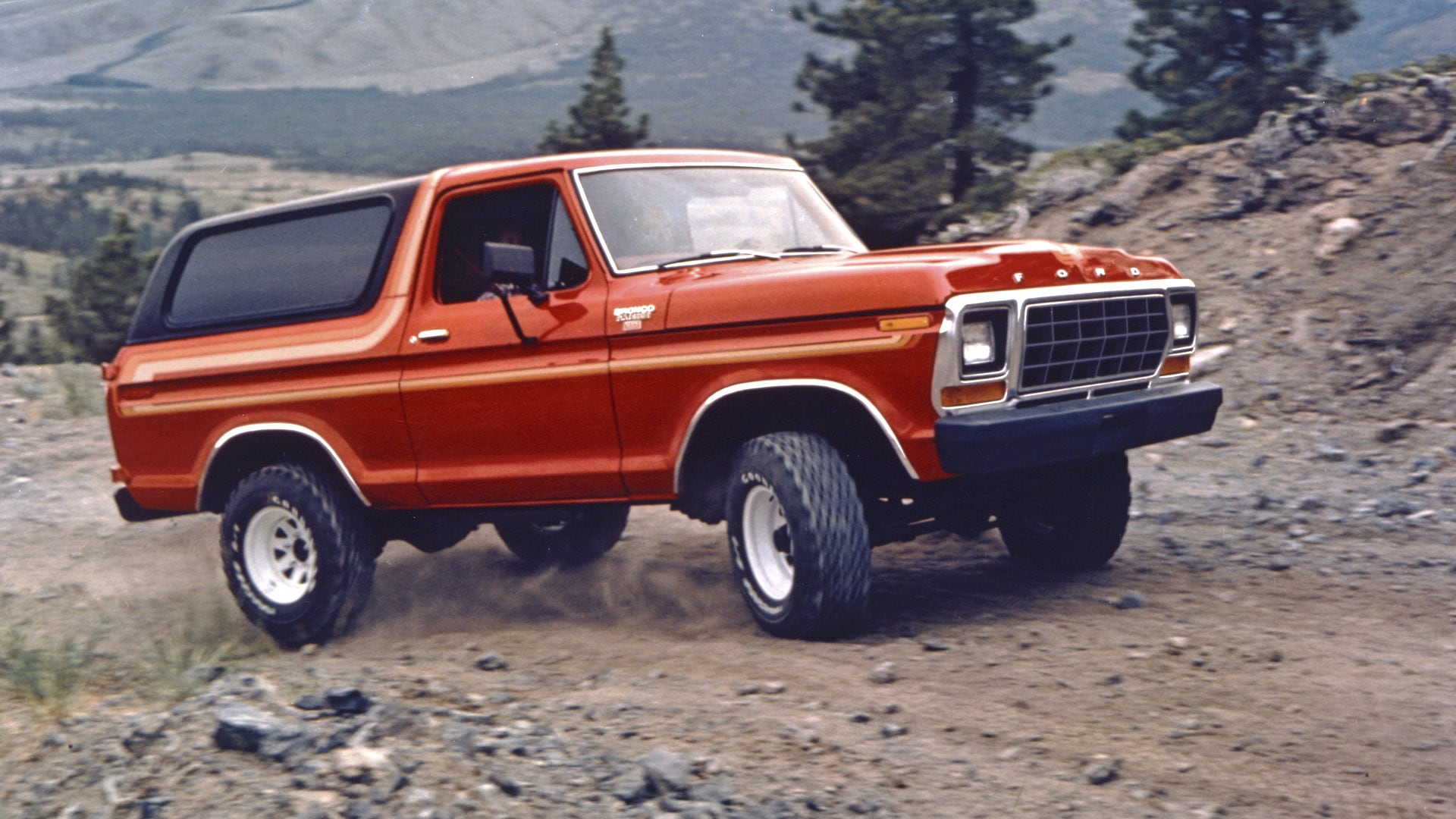
1978 Ford Bronco
© FordFord had planned the introduction of a second-generation Bronco as early as 1972. Branded as “Project Shorthorn”, the new full-size SUV model was delayed by energy concerns created from the 1973 oil crisis.
The second-generation model became the first Bronco to share a platform with the Ford F-Series pickup truck. This new chassis, with a wheelbase 12-inches longer than the first Bronco, allowed for a more spacious interior.
Only one bodystyle would be offered. All second-generation Broncos would come in three-door form, with a removable hardtop roof panel. Offered with two front seats as standard, buyers could opt for a three-seater front bench, and add an extra rear bench.
The demand for a new Bronco could be seen by the sale of almost 78,000 vehicles in 1978.
-
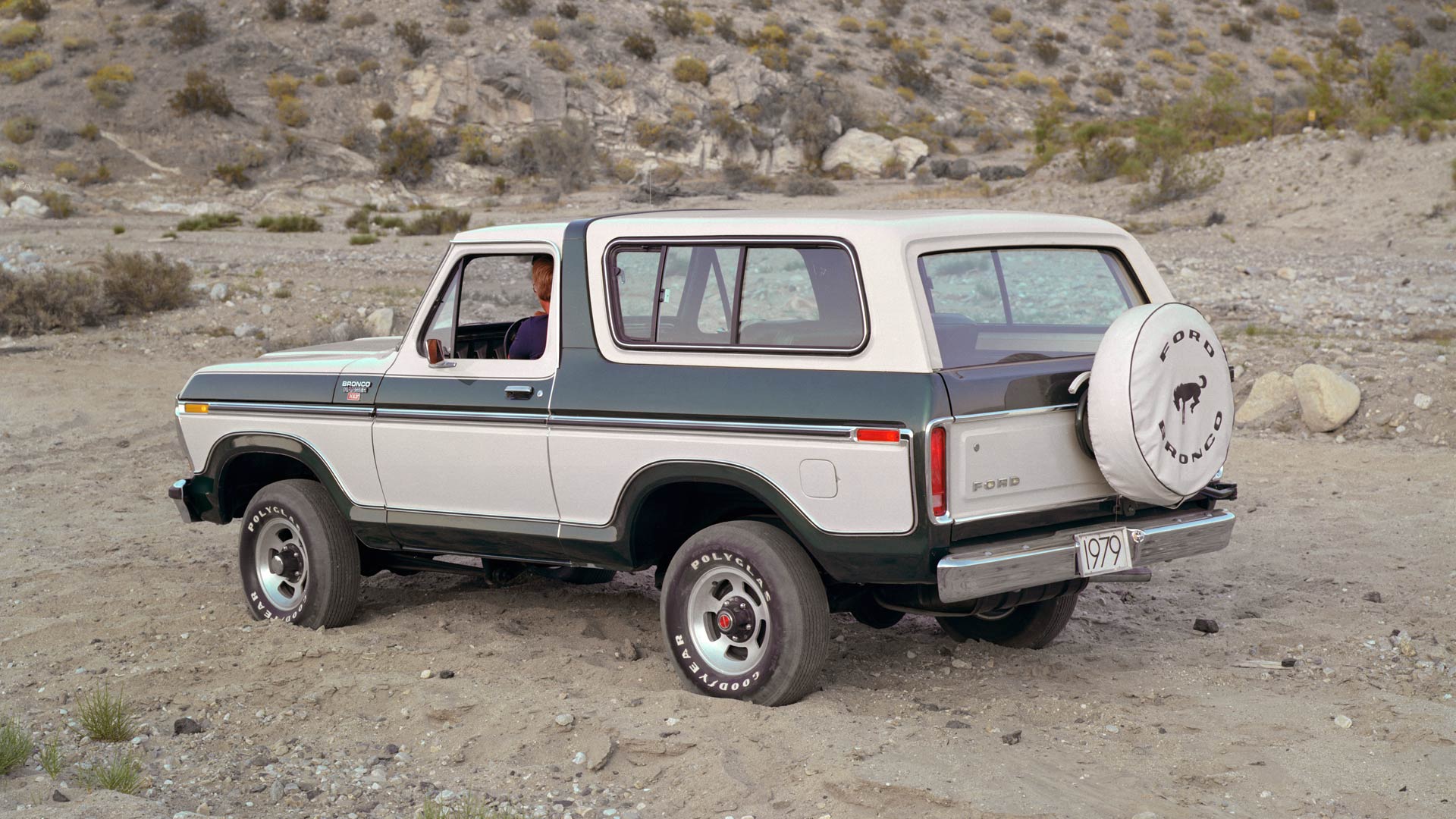
1979 Ford Bronco
© FordUnlike the original model, the second-generation could only be ordered with a V-8 engine. A 351-cubic unit was standard, with a torquier 400-cubic inch engine found on the options list. For 1979, these engines gained a catalytic converter, albeit with minimal impact on performance.
The Bronco was still four-wheel drive as standard. A semi-permanent setup could be replaced with a permanent option if desired. Transmission choices were either a four-speed manual, or a three-speed automatic.
-
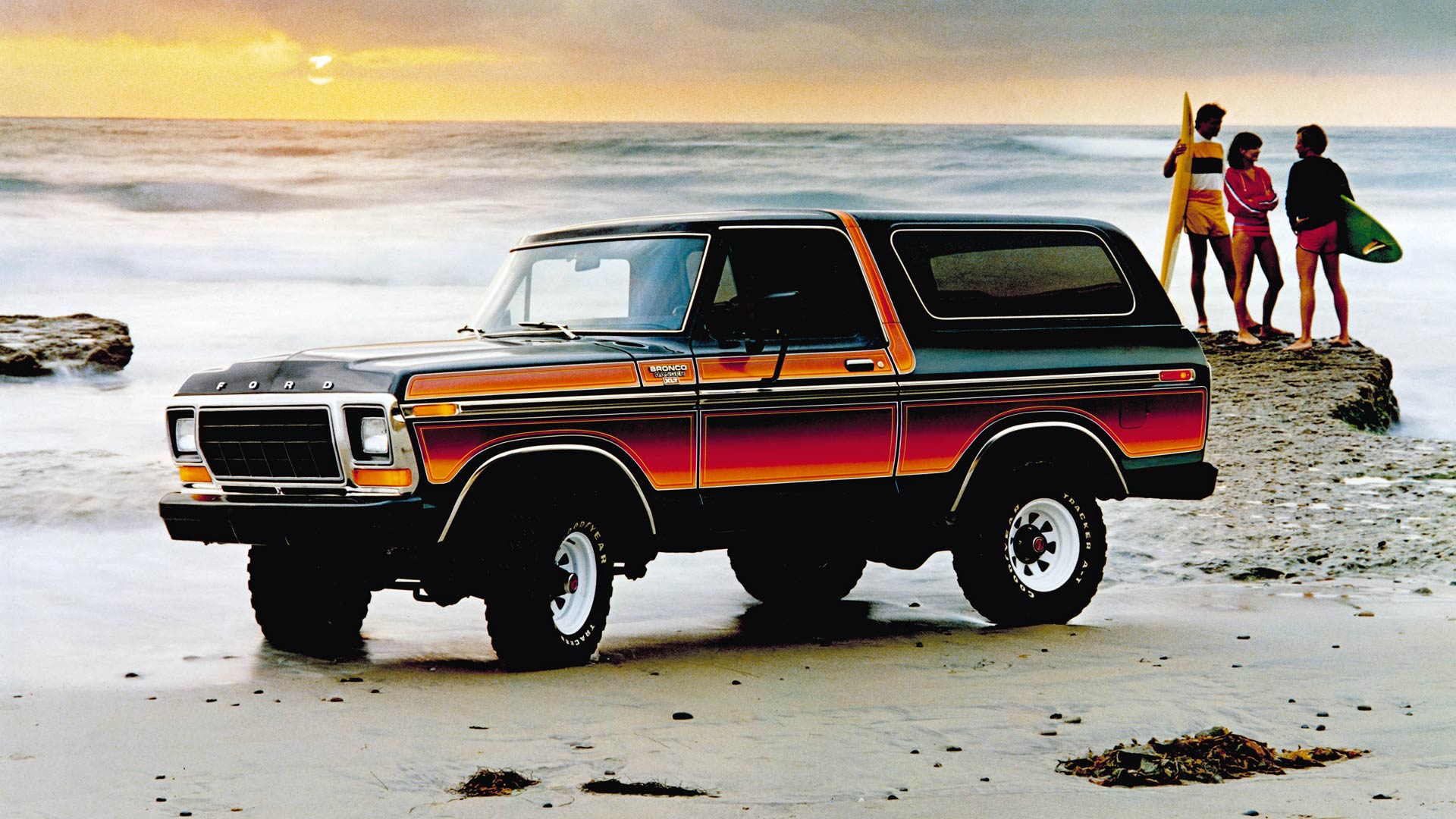
1979 Ford Bronco
© FordChanges for the 1979 model included square headlights becoming standard, along with captain’s chairs for the interior. Buyers could specify a bold Free Wheelin’ package, adding an extra dose of late-1970’s style.
With the introduction of the second-generation Bronco having been heavily delayed, 1979 would be its second and final year of production. It would also be one of the best years ever for the Bronco, with over 104,000 being sold.
-
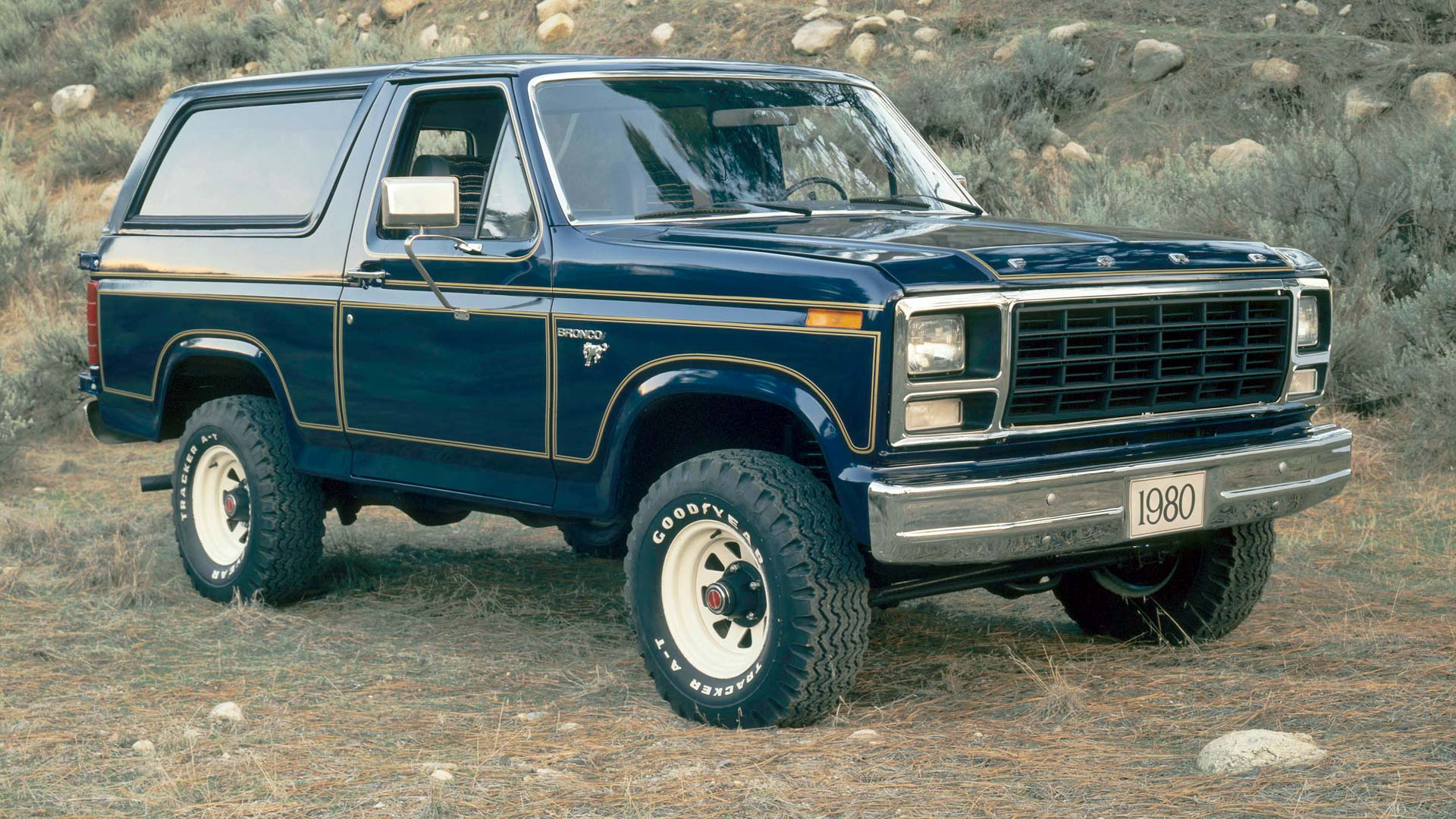
1980 Ford Bronco
© FordWith the second-generation model already outdated before it was launched, a third-generation of the Bronco made a debut for 1980. Although it still shared a platform with the Ford F-Series pickup, the third iteration was intended to deliver improved fuel economy.
This meant the return of a six-cylinder engine, with a 4.9-liter unit the base offering. Buyers could also opt for V-8 engines, offering 5.0-liter and 5.8-liter displacements. Fuel injection would follow as part of a mid-life update.
Four-wheel drive remained part of the standard Bronco setup, with the six-cylinder model offered only with a four-speed manual transmission. The ancient three-speed automatic remained, until Ford’s newer AOD gearbox was made available later in production.
-
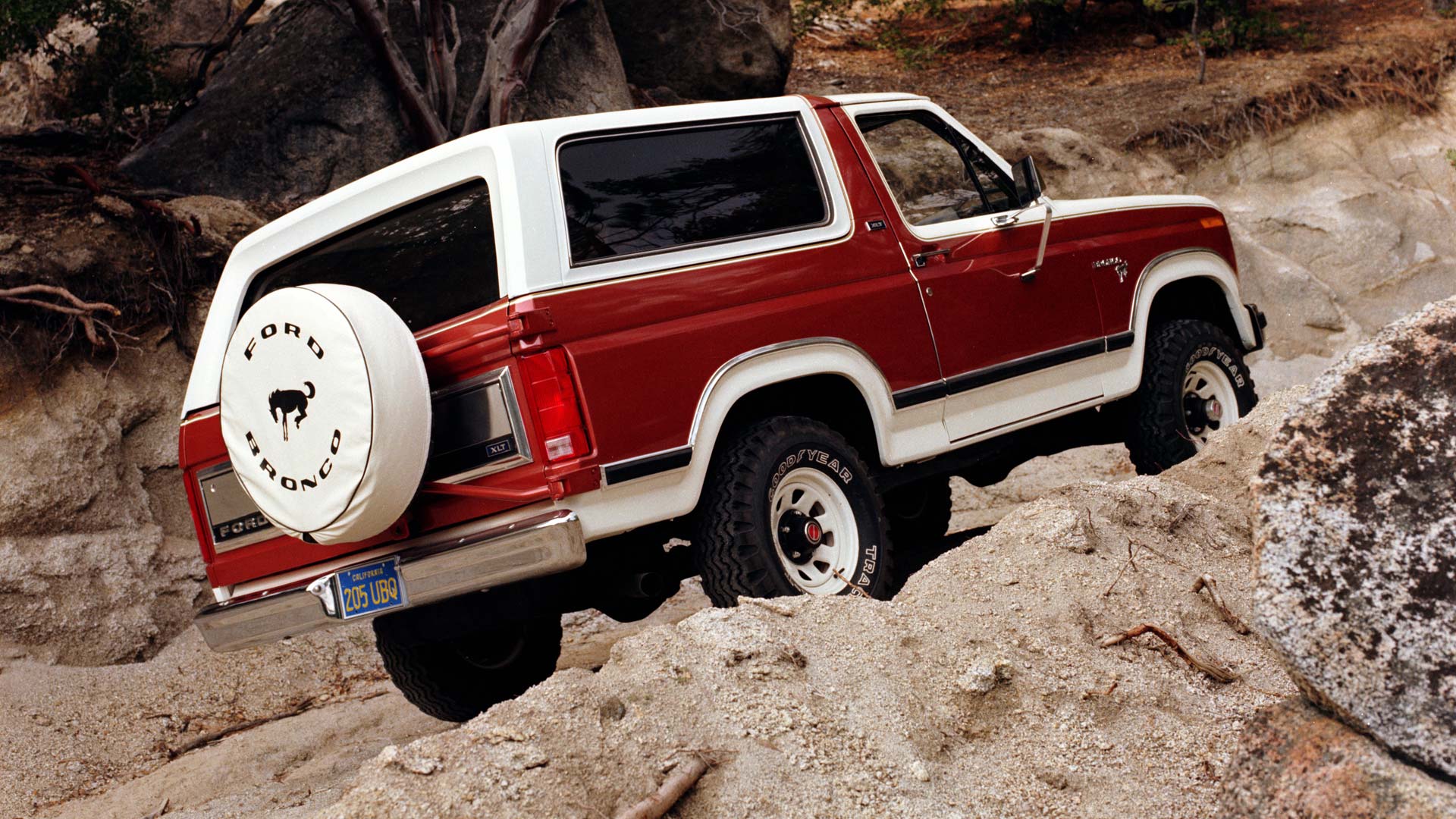
1980 Ford Bronco XLT
© FordFord used the same trim levels as the F-Series pickup for the Bronco, with XLT being the range-topping choice in 1980. Plumping for the XLT model meant luxuries such as the choice of cloth trim or patterned vinyl, along with cut-pile carpeting throughout the interior.
The accessories list for the Bronco was extensive, ranging from air conditioning to a CB radio. Buyers had a choice of colors for the removable fiberglass roof panel, with a rear bench seat still only an option.
-
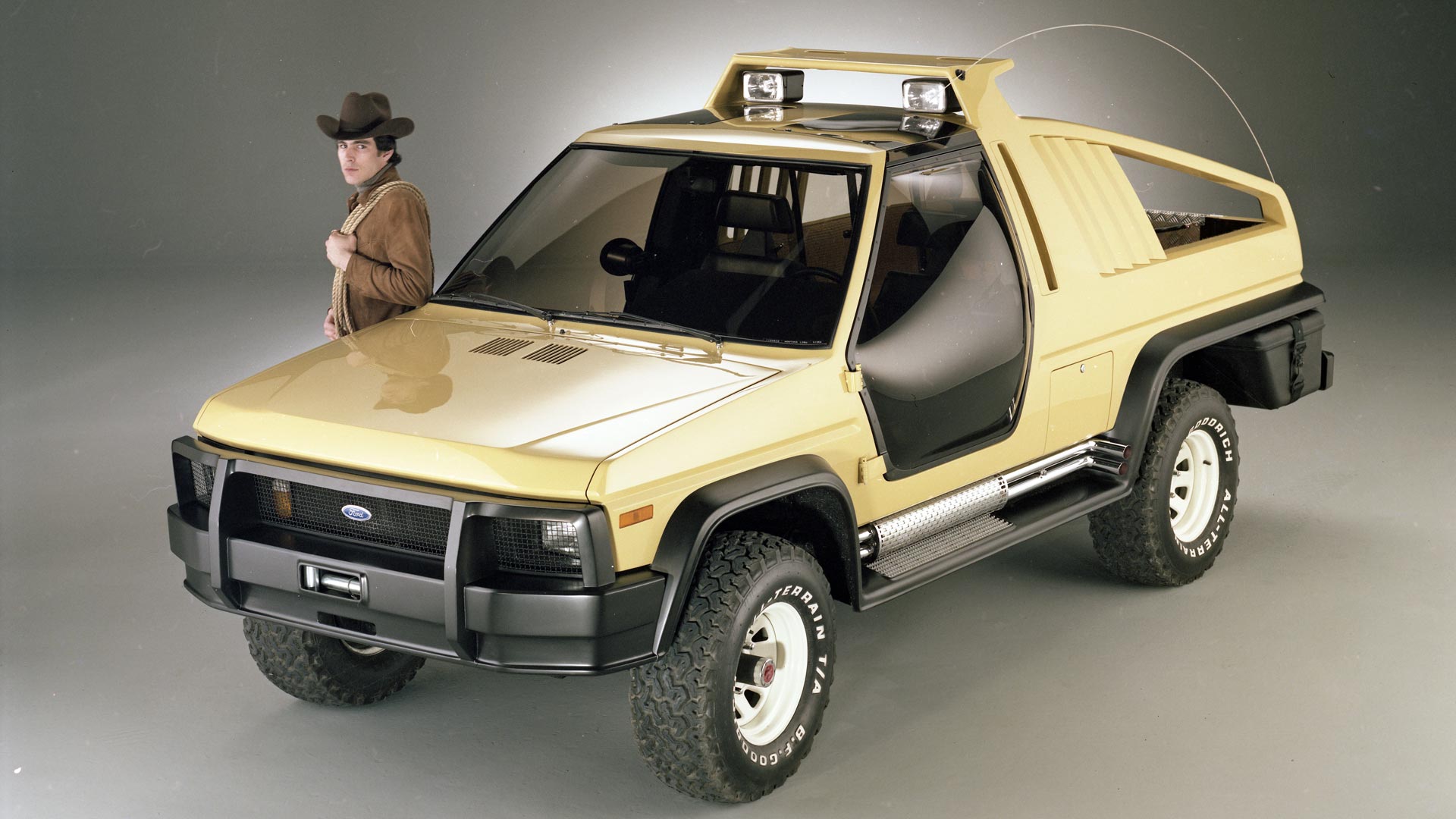
1981 Ford Bronco Montana Lobo Concept
© FordFord continued with Bronco concepts into the 1980s, displaying the Montana Lobo at the 1981 Chicago Auto Show. Underneath was a chassis from a 1977 Bronco, with the styling a mixture of traditional SUV and pickup truck elements.
Ford wanted to gauge the reaction to the idea of a smaller pickup truck, while also adding futuristic elements to the Montana Lobo. Perspex doors, a truck bed lined with hemp, and a digital dashboard were substantially more advanced than the technology found in the contemporary Bronco.
-
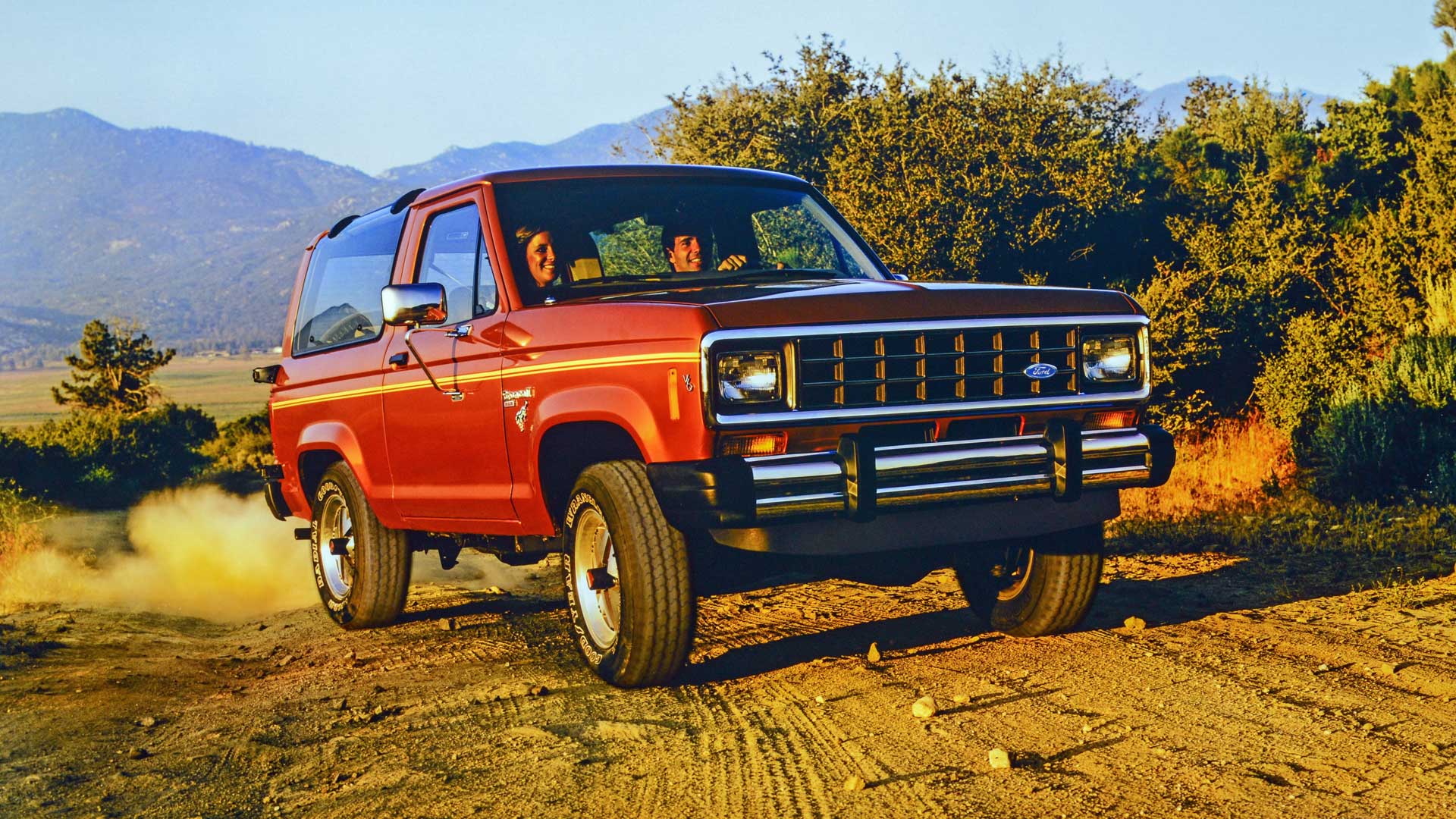
1984 Ford Bronco II
© FordIntroduced alongside the Ford Ranger pickup truck, the compact Bronco II shared only a name with the full-size SUV. With a wheelbase ten inches shorter, the Bronco II was intended to compete with the Chevrolet S10 Blazer and Jeep Cherokee.
Initially offered with four-wheel drive, a rear-wheel drive model would be added in 1986. A 2.8-liter V-6 was the standard engine, replaced by a larger fuel-injected 2.9-liter V-6 in 1986. Mitsusbishi supplied a 2.3-liter turbodiesel, but this proved unpopular with customers.
Ford would continue production of the Bronco II, until replacing it with the larger Explorer. Rollover accidents associated with the Bronco II would damage its reputation, and cost Ford more than $115 million to settle lawsuits.
-
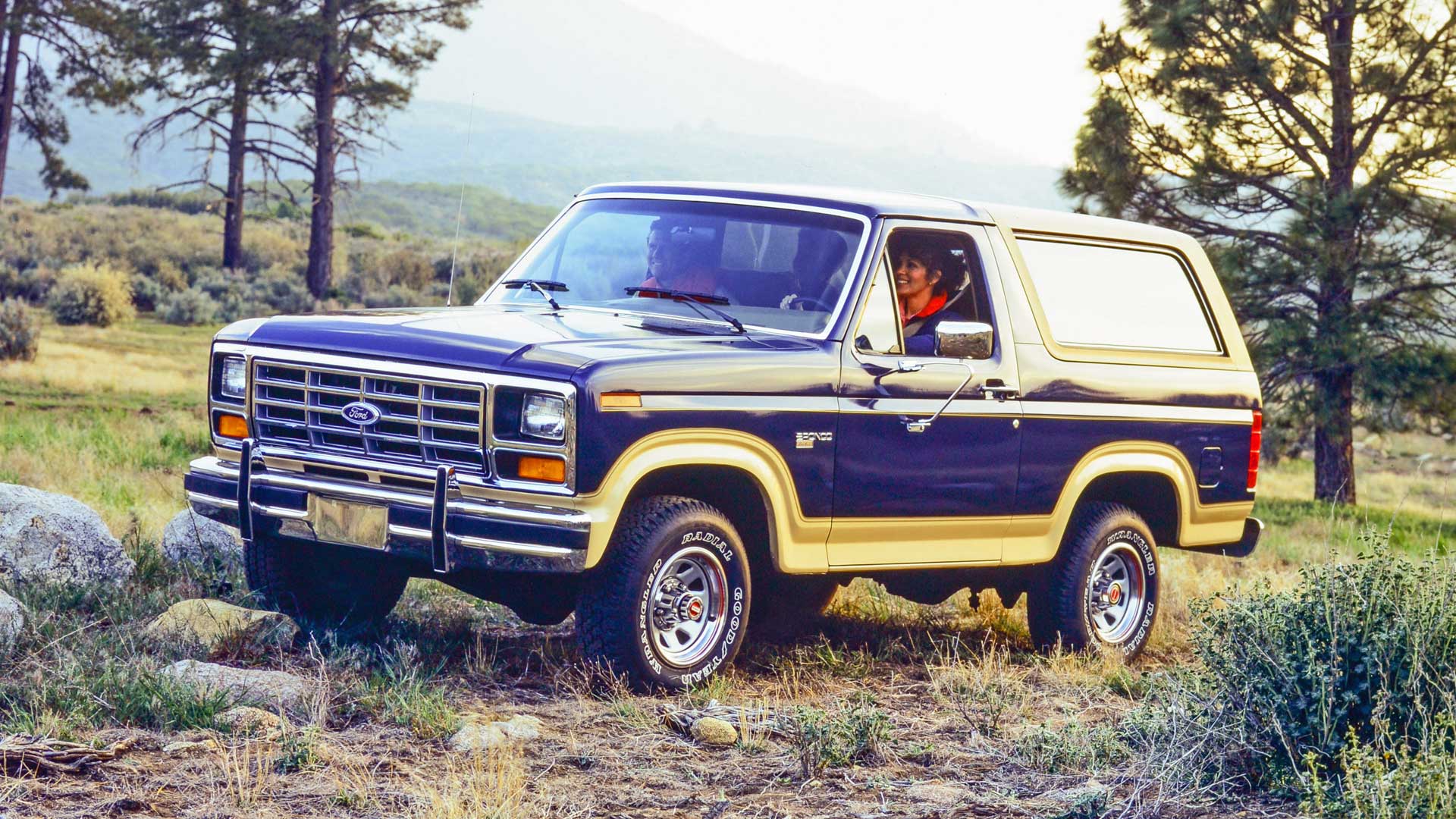
1985 Ford Bronco Eddie Bauer
© FordThe Bronco II would debut the use of the upmarket Eddie Bauer trim level. It would become available the following year for the full-size Bronco, becoming the range-topping option.
Externally, the Eddie Bauer edition Bronco could be identified by its two-tone paintwork and extra body stripes. Privacy glass and steel wheels in a shiny argent finish were further exterior accoutrements.
-
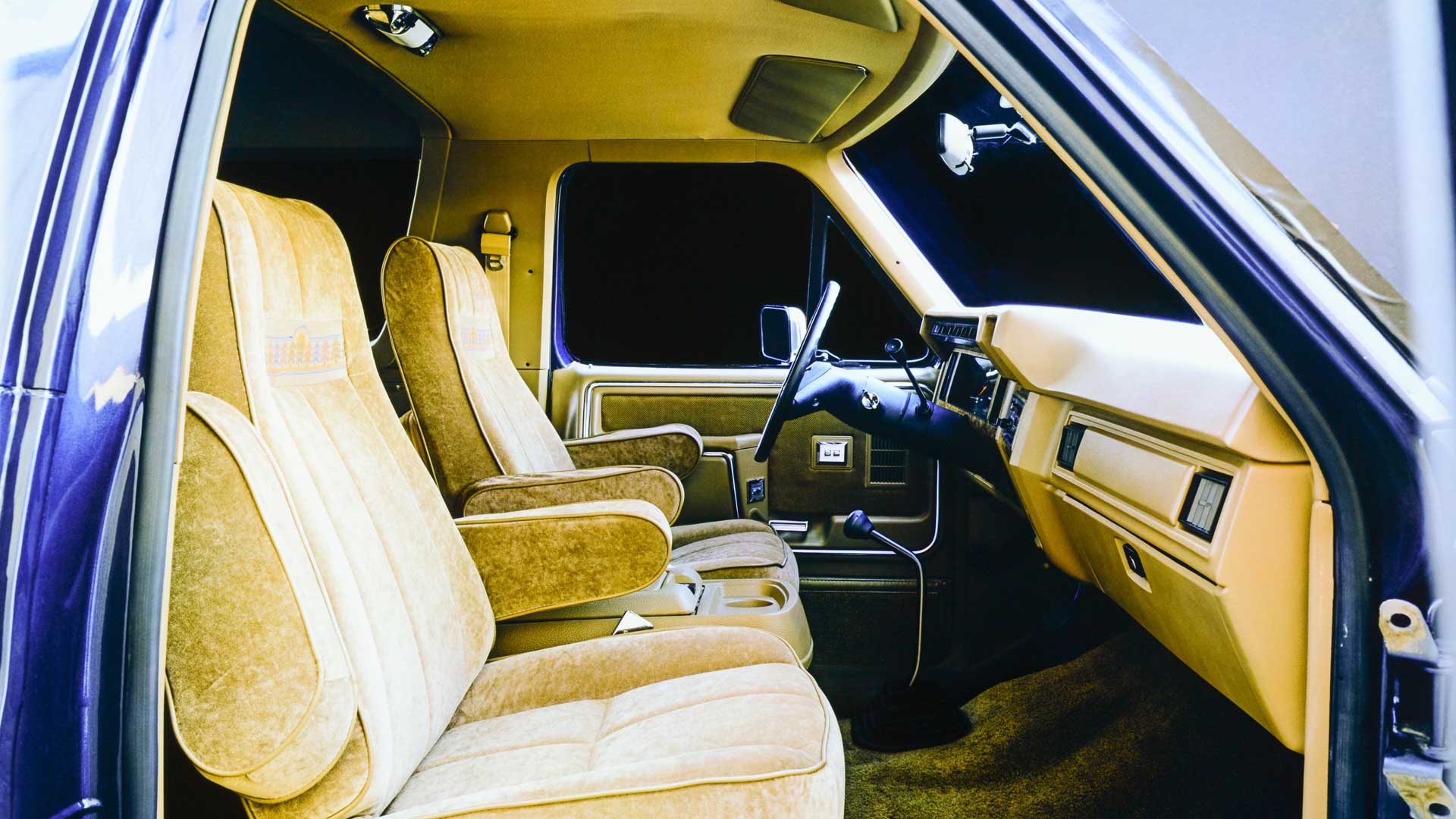
1985 Ford Bronco Eddie Bauer Interior
© FordInside was where the Eddie Bauer Bronco delivered an even greater dose of luxury. Air conditioning was standard, along with cruise control and a tilting steering wheel.
The front seats were captain’s chairs, upholstered in a deep tan cloth. Folding armrests, and special storage pockets on the seatbacks, were also unique to the Eddie Bauer model. All of this was completed with deep carpeting and a standard rear bench.
With 54,000 Broncos sold in 1985, and over 62,000 the following year, the Eddie Bauer trim proved to be a winner.
-
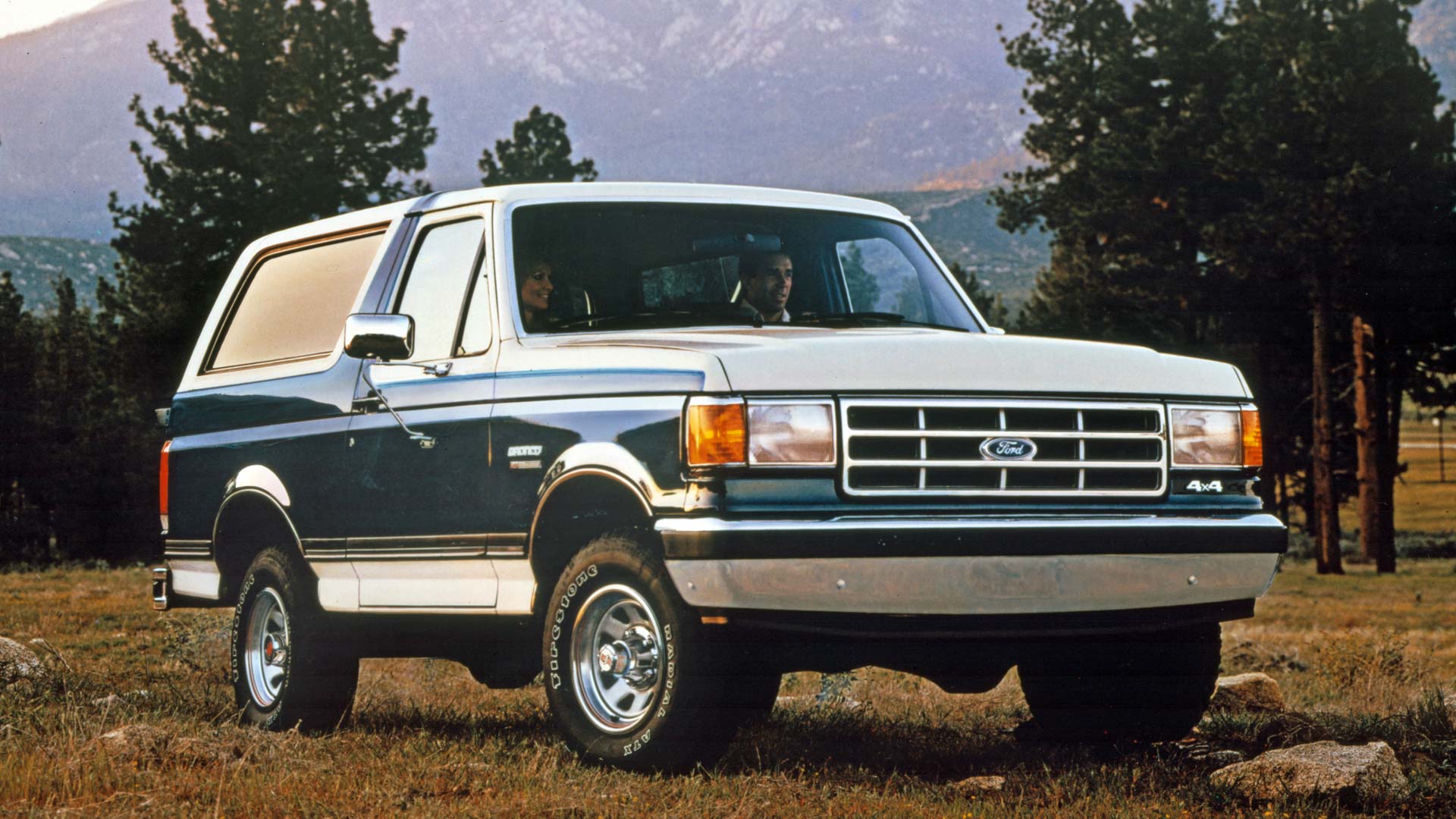
1987 Ford Bronco
© FordFollowing a major overhaul of the Ford F-Series pickup truck the year before, the Bronco also received the new streamlined styling update. Referred to by some as the “brick nose” Bronco, changes included a smaller front grille, round fenders, and a smoother front bumper.
Engine options for the fourth-generation Bronco remained the same, but with fuel injection now found on the 4.9-liter six-cylinder. The 5.0-liter and 5.8-liter V-8s were also fuel injected, with Ford introducing updated transmissions.
This included finally discontinuing the prehistoric three-speed automatic in 1990, with a five-speed Mazda-sourced manual introduced.
-
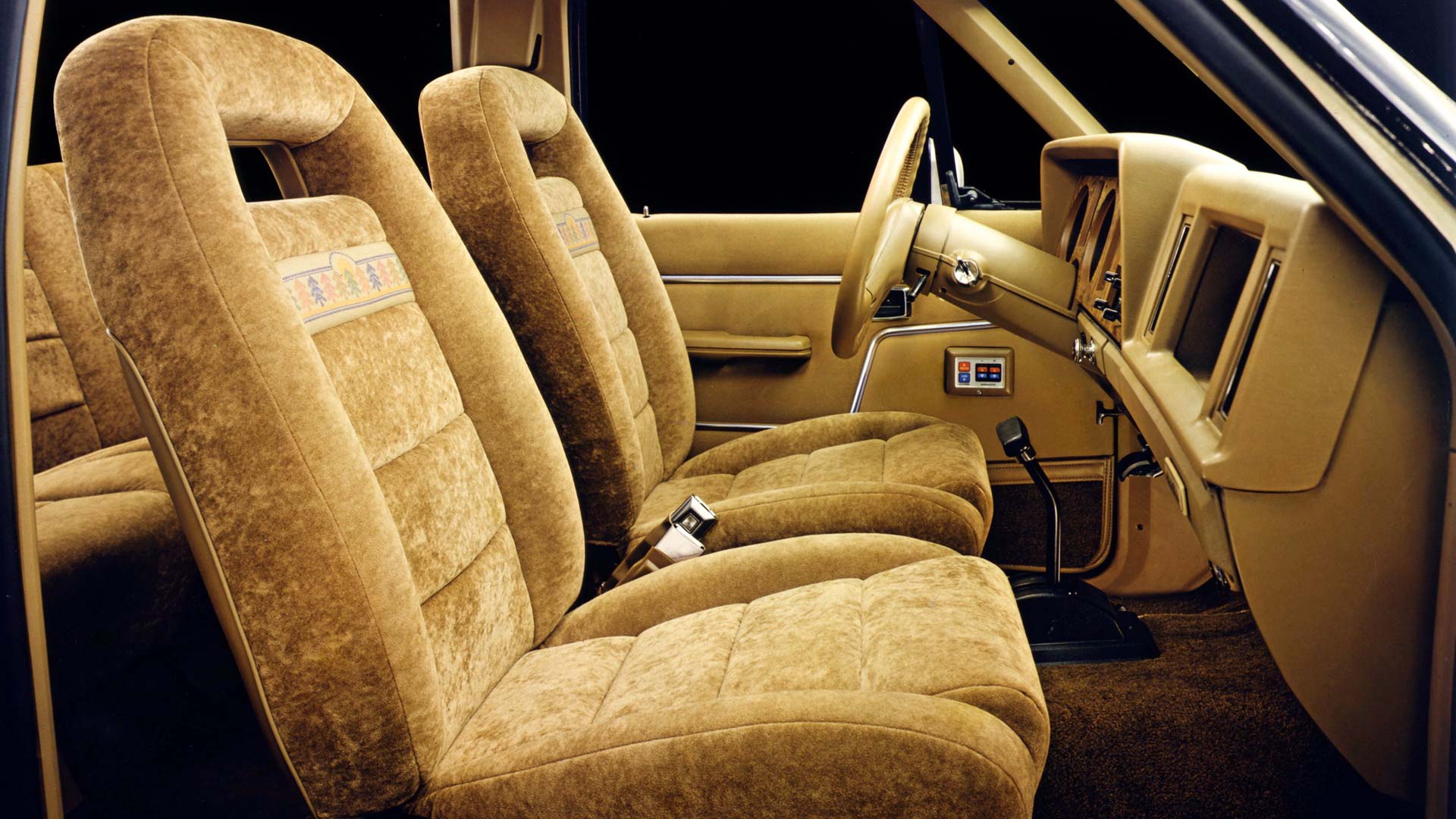
1987 Ford Bronco Interior
© FordFord continued to modernize the fourth-generation Bronco, with anti-lock rear brakes becoming standard. Four-wheel drive remained, but buyers now had the option to specify a push-button transfer case with certain drivetrains.
The interior received a comprehensive update, with a new steering wheel and revised dashboard. Ford promised improved quality, along with greater comfort from new seats. Tinted windows, an AM radio, and power steering were all standard equipment.
-
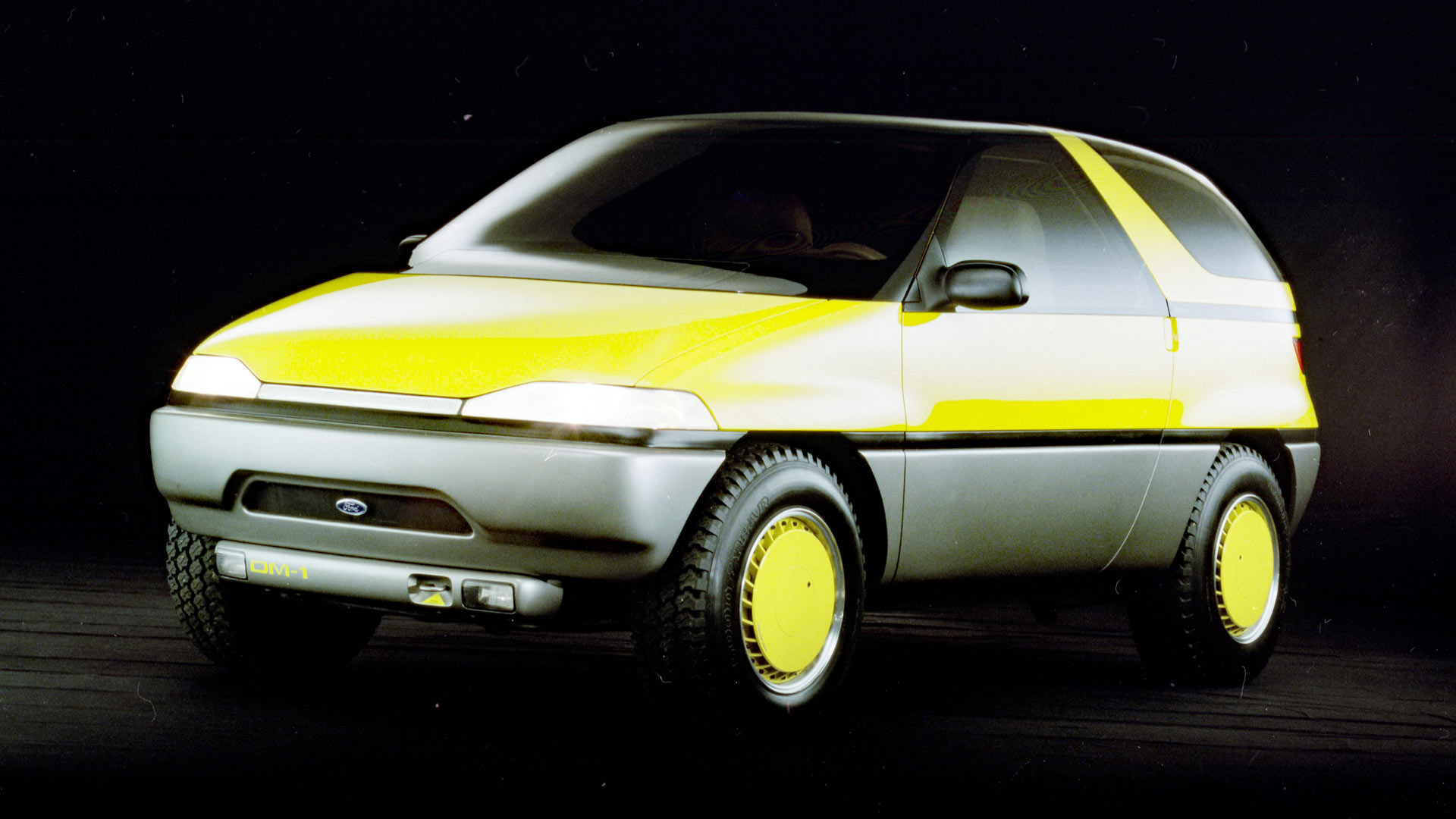
1989 Ford Bronco DM1 Concept
© FordDeveloped through an industrial design contest sponsored by Ford, the DM1 Concept marked a radical departure for the Bronco name. The DM1 was created upon a Ford Escort chassis, and used a four-wheel drive system from the Bronco II.
The fiberglass bodywork had clearly been influenced by minivan design, while the interior was light and airy. It even incorporated an early satellite navigation system.
-
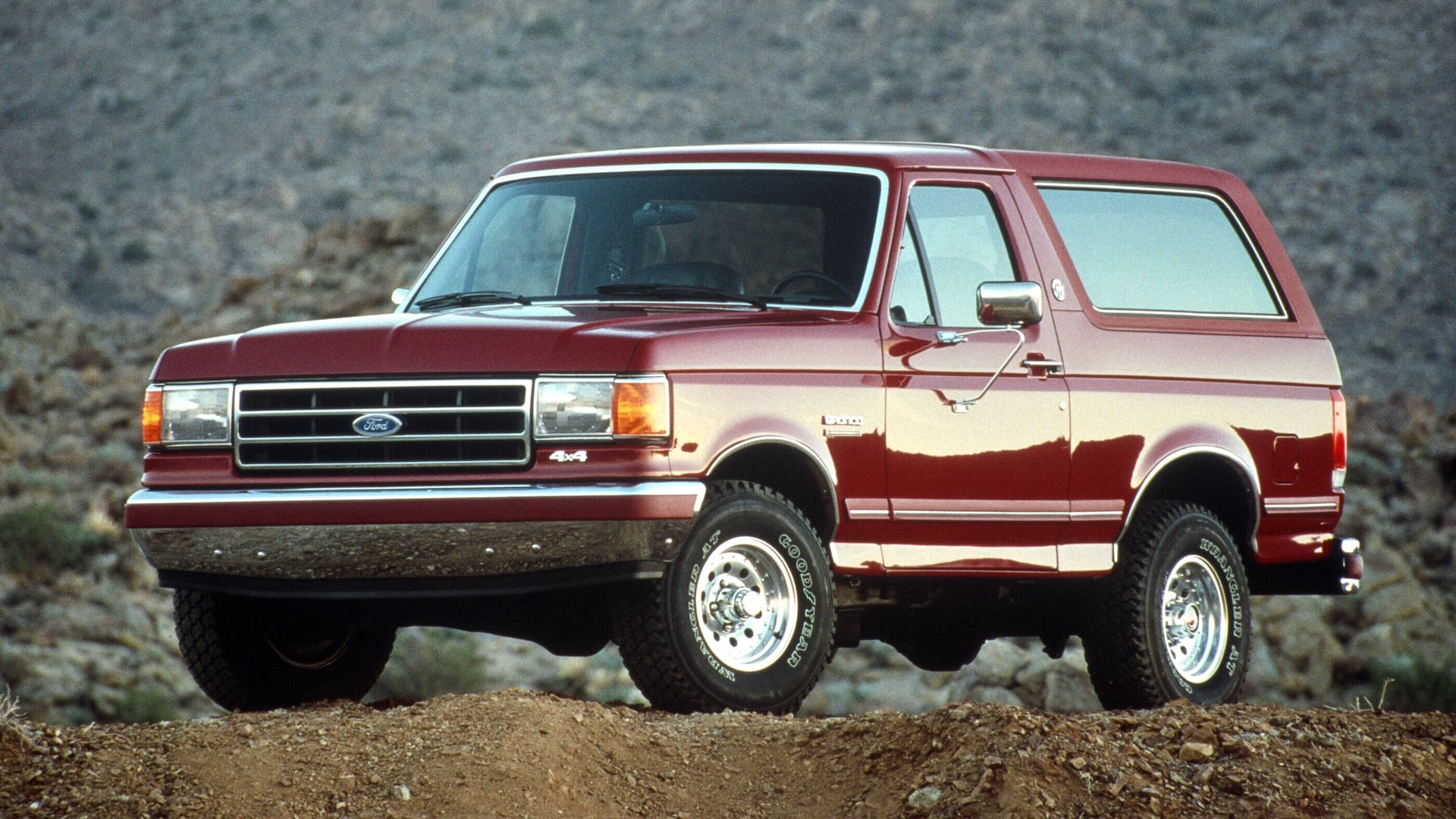
1991 Ford Bronco Silver Anniversary Edition
© FordFord commemorated 25 years of Bronco production in 1991 by releasing a special limited-edition model. Offered for just one year, the Silver Anniversary package meant having your Bronco painted in exclusive Currant Red.
Inside, the Silver Anniversary Bronco marked the first use of standard leather upholstery. Finished in gray, the leather seats were complemented by special carpeting, bespoke floor mats, and commemorative badging.
-
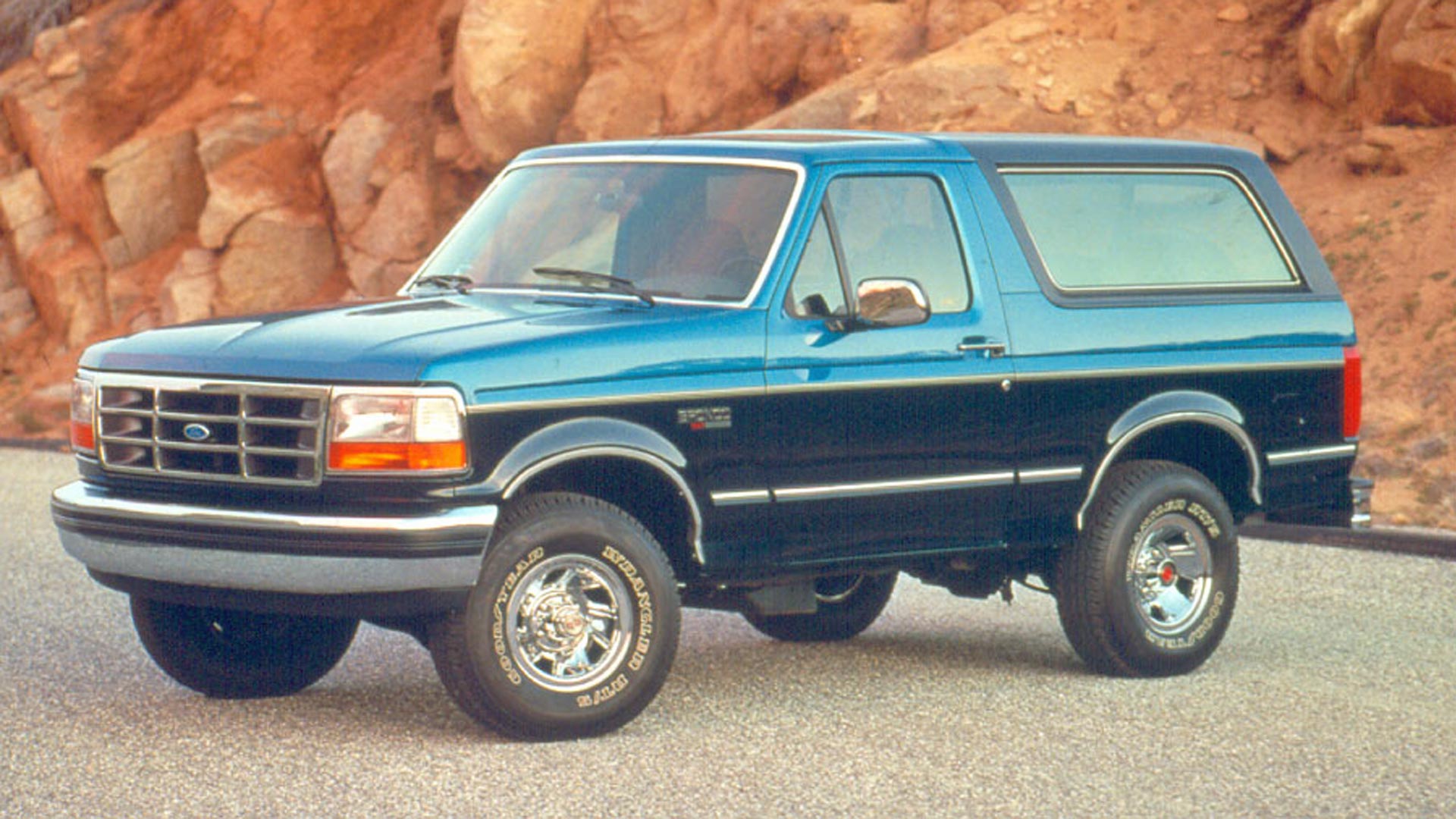
1992 Ford Bronco
© FordWith Ford continually updating the F-Series pickup truck, the related Bronco received a refreshed design for 1992. The fifth-generation Bronco may have retained the same chassis underneath, but Ford said that this was the “smartest” version ever.
Exterior changes included a new larger front grille and reprofiled headlights, with the dashboard also gaining a modernized layout.
Changes in safety legislation meant that Ford no longer listed the Bronco as featuring a removable roof. Seat belt mounting points were now fixed to the hardtop inside, with a high-level brake light on the outside, preventing its removal.
-
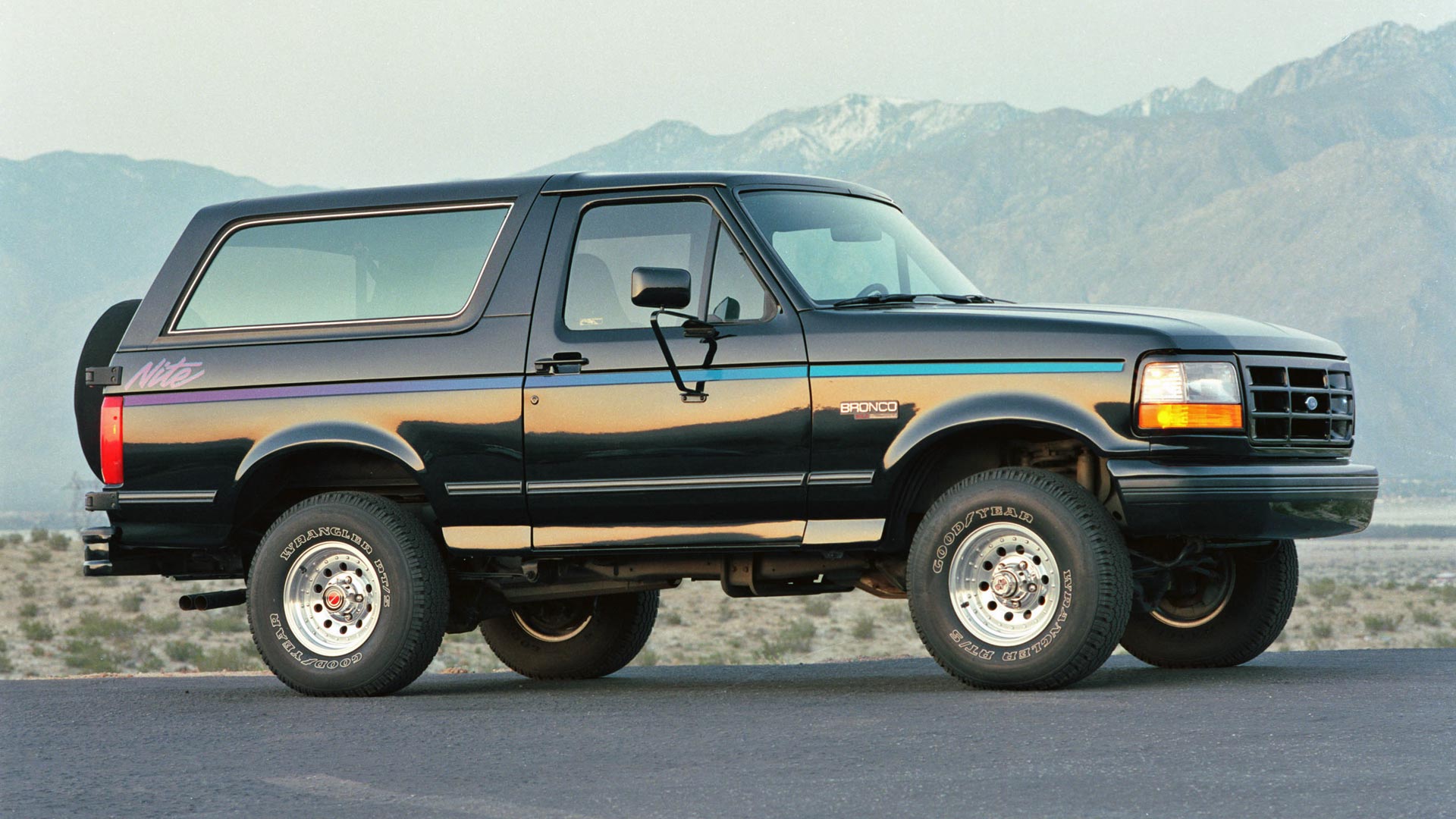
1992 Ford Bronco Nite Edition
© FordAs previously seen on the fourth-generation Bronco, the special Nite edition was made available solely for the 1992 model year. Based upon the XLT trim level, Ford described it as being a “bold choice”.
Offered only with Raven Black paintwork, the Nite edition came with unique stripes and lettering on the outside. Buyers could pick from a selection of upholstery colors for the interior, but all came with black trim and Nite floor mats.
Powering the Nite edition was the 5.0-liter V-8 engine, with an automatic transmission or larger 5.8-liter V-8 optional.
-
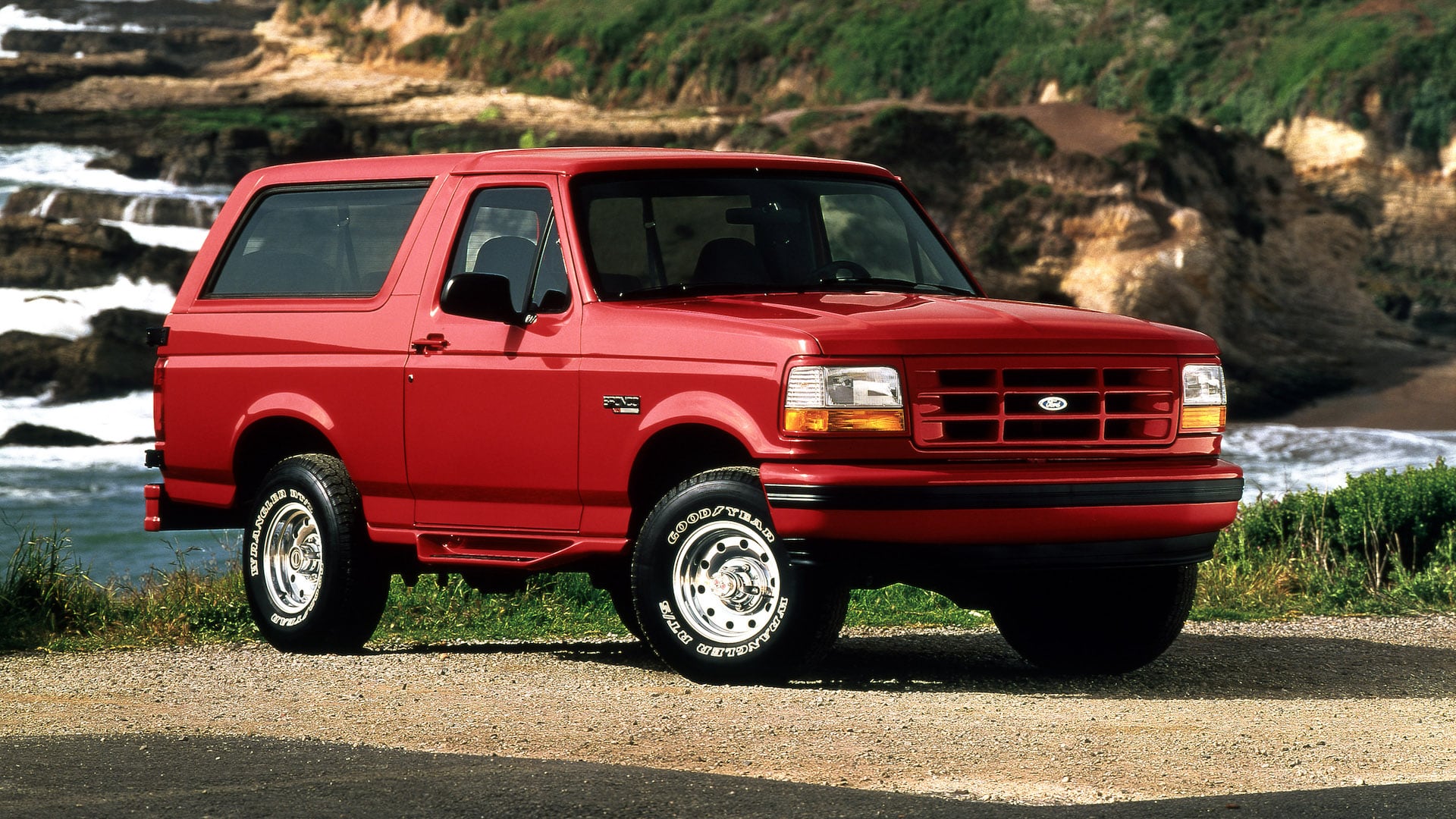
1995 Ford Bronco XLT Sport
© FordDespite the age of the Bronco, Ford continued to update the fifth-generation model. Anti-lock brakes for all four wheels became standard equipment in 1993, followed by a driver’s airbag in 1994. The six-cylinder engine had also been dropped in 1993.
Ford launched a new option package for 1995, with the XLT Sport intended to deliver “style and comfort”. The most obvious additions were the color-coded front grille, bumpers, and headlight surrounds.
Black aerodynamic side mirrors, and integrated side steps, completed the visual makeover. Bright Red Clearcoat paint was an exclusive option for the XLT Sport model.
-
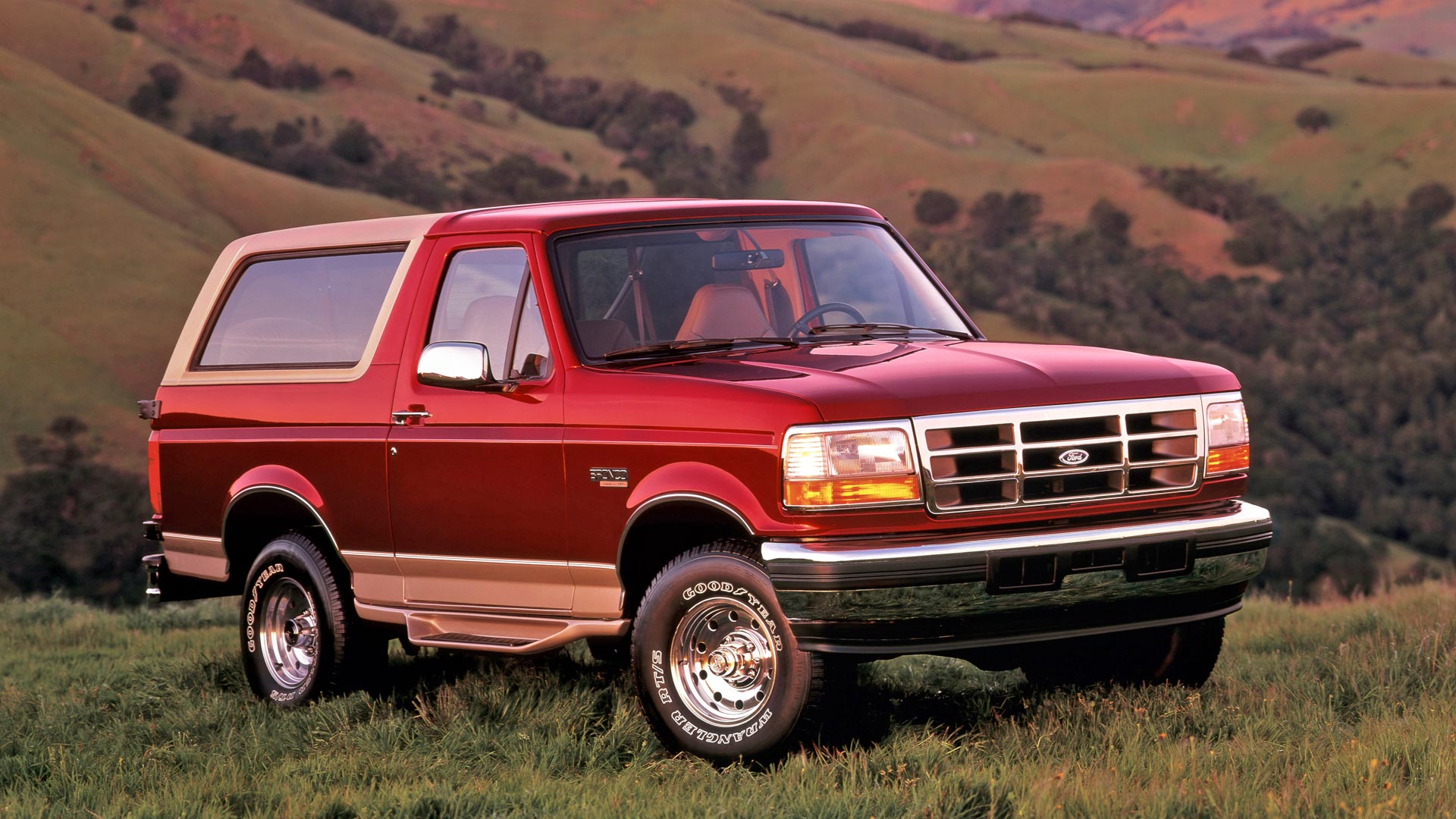
1996 Ford Bronco
© FordWith the market for SUVs continuing to evolve, Ford made the decision to discontinue the Bronco. The final example would leave the Michigan Assembly Plant in June 1996, with some 34,000 Broncos having been built in the final year.
Ford introduced the brand-new Expedition for the 1997 model year. With five doors, and the option of three-row seating, it was designed to compete with modern rivals like the Chevrolet Suburban.
After selling more than one million examples, the classic two-door SUV and Bronco nameplate would disappear from the Ford range for over two decades.
-
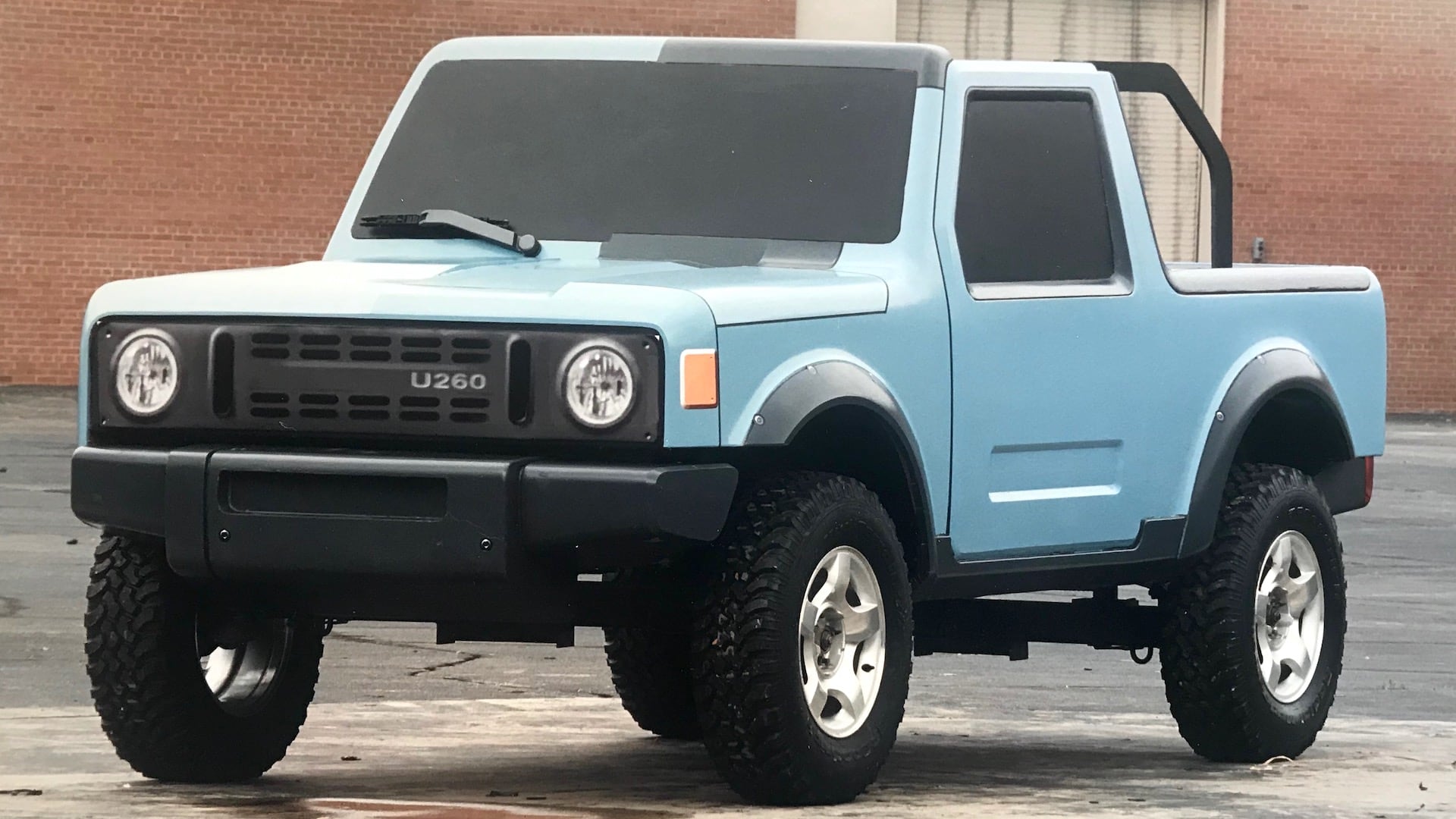
1999 Ford U260 Concept
© FordThe Bronco may have gone from showrooms, but some at Ford understood the loyalty enthusiasts had shown to it. Designer Moray Callum, and a handful of other Ford employees, created a plan for a reborn Bronco.
Nicknamed the U260, it would be pitched at younger buyers, with retro looks designed to tempt them away from Jeep Wranglers.
However, the late 1990s would see Ford mired in financial problems from the Firestone tire scandal. It left Ford unable to justify the expenditure on another SUV, leaving the U260 on the drawing board.
-
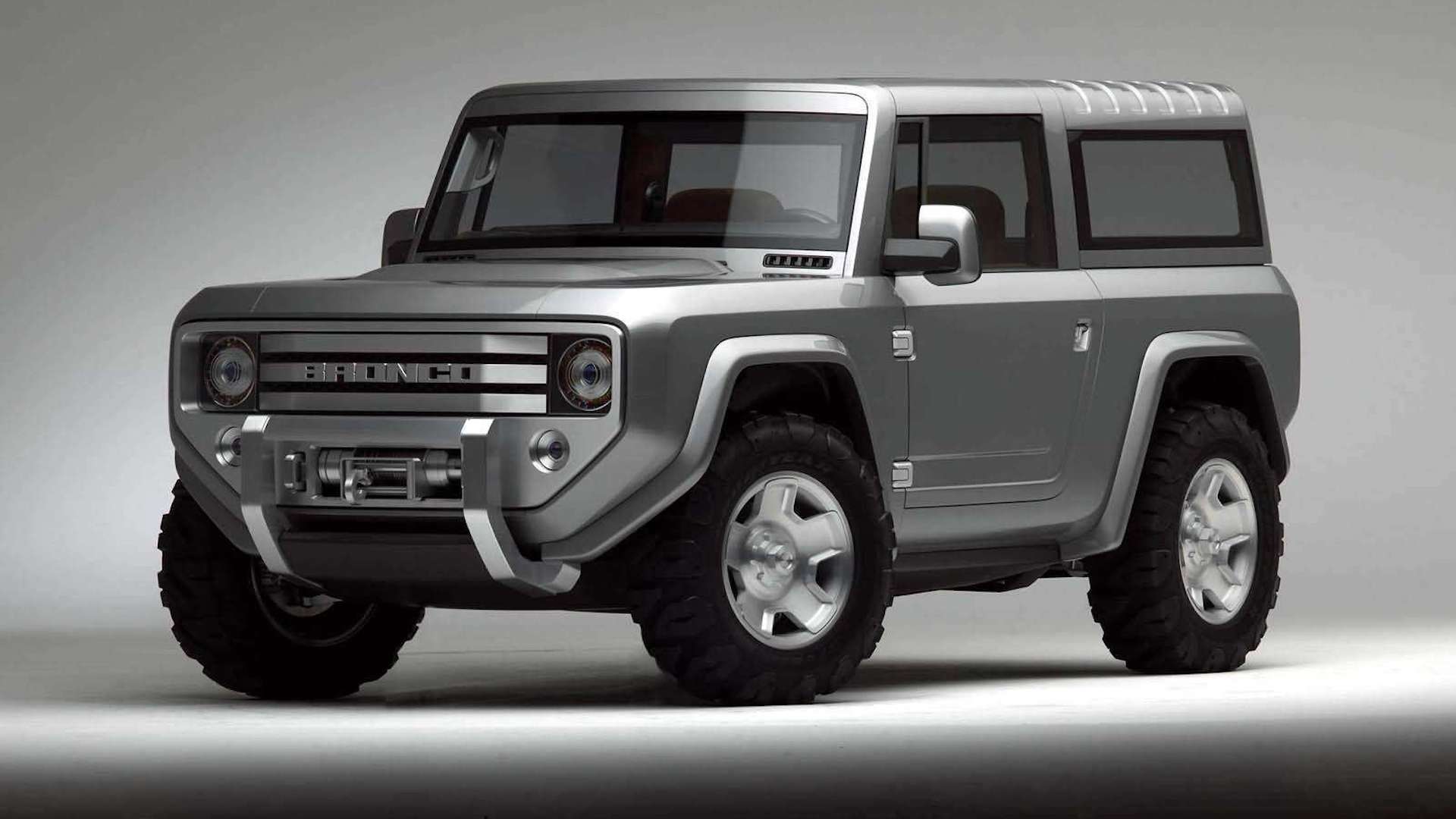
2004 Ford Bronco Concept
© FordAlmost as if to taunt Bronco fans, a concept model appeared at the 2004 Detroit Auto Show. Featuring a blend of retro styling and modern touches, the 2004 creation was on the Ford stand along with a Shelby Cobra Concept.
Curiously, Ford opted to fit the Bronco Concept with a 2.0-liter turbodiesel engine, sourced from the European Mondeo. It offered 128 horsepower and 244 lb-ft of torque, and was matched with an all-wheel drive system.
Other than an appearance in the 2018 movie, Rampage, the concept remained on ice.
-
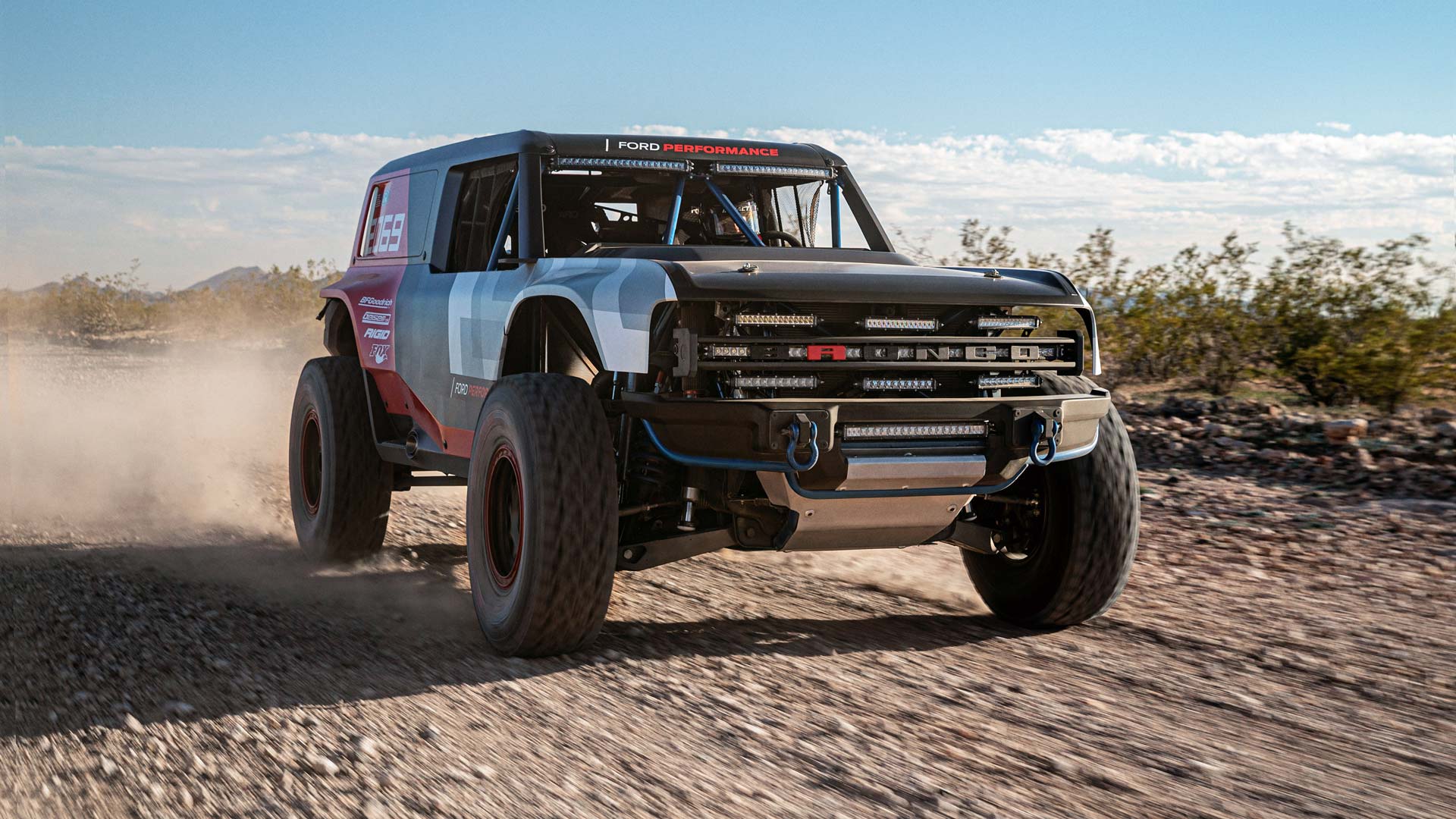
2019 Ford Bronco R Prototype
© FordAfter more than two decades, Ford began dropping hints that a new Bronco could finally be a reality in 2019. Built to compete in the Baja 1000 race – just like the original Big Oly Bronco – the 2019 Bronco R tested engine and transmission components.
Although the styling gave little indication to how a street-legal Bronco could look, it demonstrated that Ford was now serious about a new SUV.
In the Baja 1000 race, the Bronco R would only manage 580 miles of the epic event. Aftermarket suspension parts, combined with a cooling fan failure, saw the Bronco retired early.
-
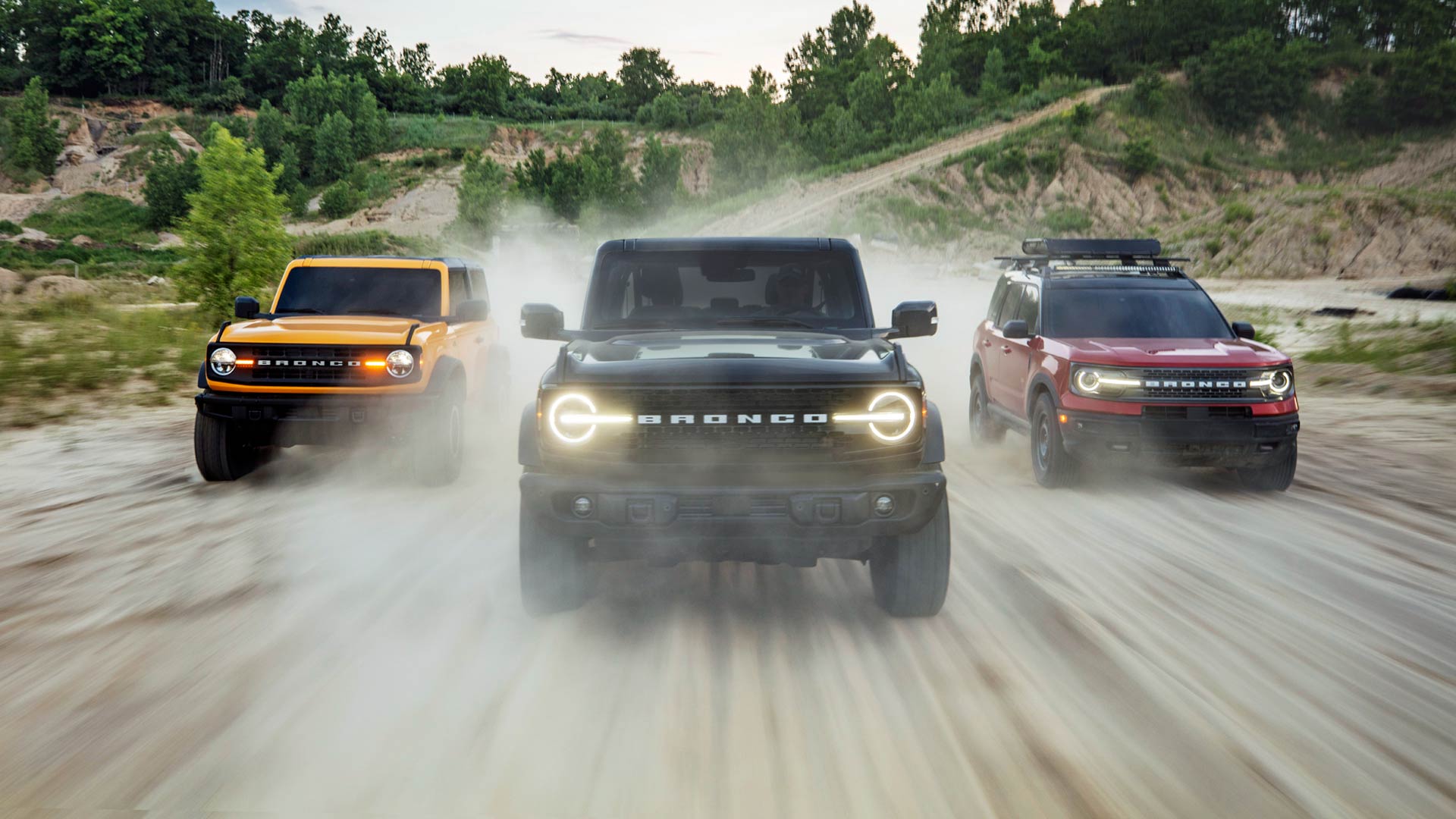
2021 Ford Bronco Family
© FordFinally, after decades of expectation and months of excitement, Ford announced not one but three new Broncos in July 2020. With a reveal aired across the National Geographic, ESPN, and ABC TV channels, the return of the Bronco was primetime entertainment.
Manufacturers typically stagger the release of different body styles over time. With the simultaneous launch of the Bronco Two Door, Bronco Four Door and Bronco Sport, Ford went all out with the 2021 Bronco family.
-
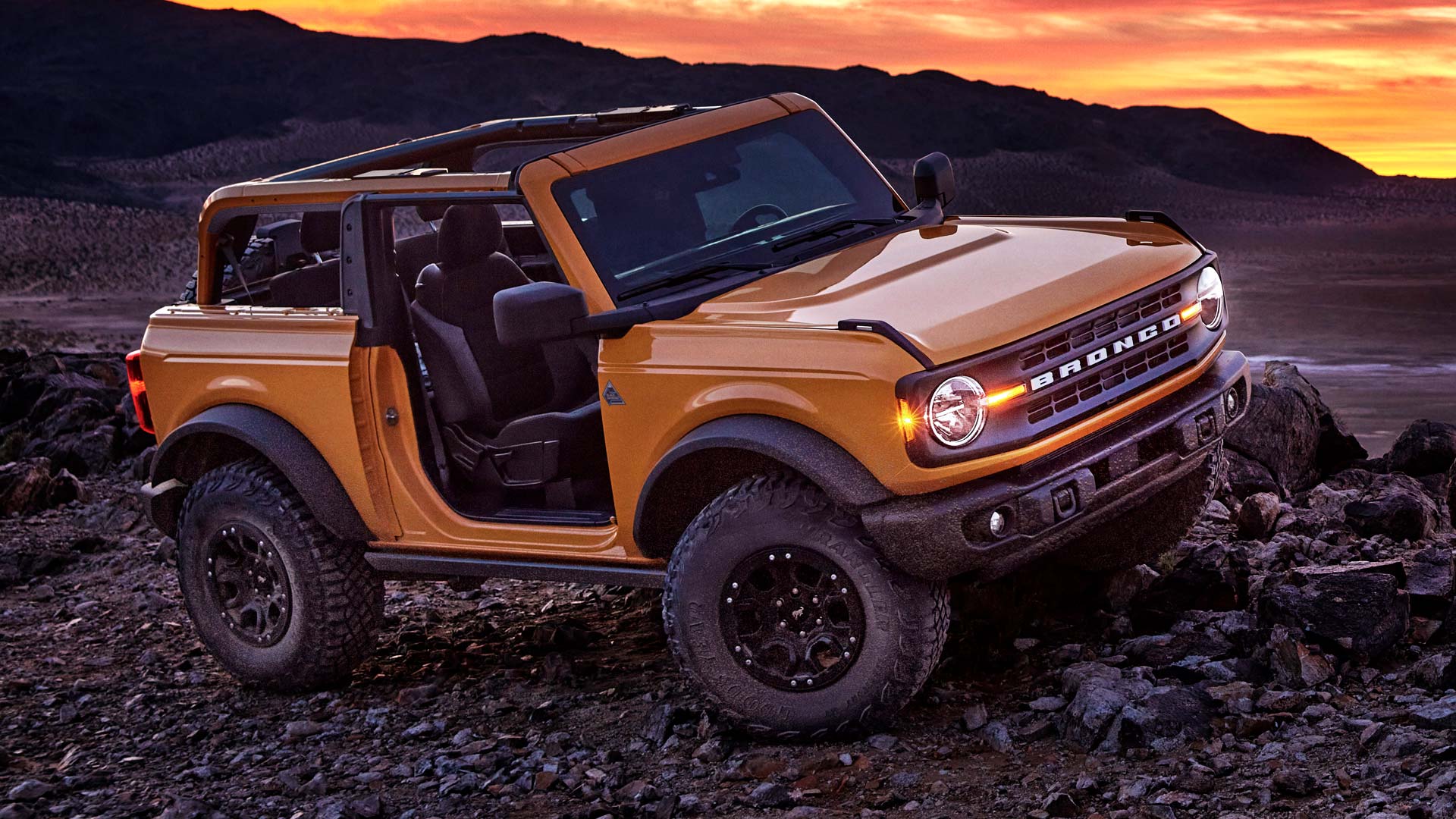
2021 Ford Bronco Two Door
© FordThe resemblance of the two-door Ford Bronco to the first-generation model is no accident. A 1976 Bronco, belonging to Ford designer Moray Callum, was digitally scanned to act as a reference point for the new model.
It meant that the two-door Bronco closely matches the proportions of the original, with multiple details paying homage to the SUV from 1966.
Off-road ability has also been maximised for the new Bronco, with multiple options for the G.O.A.T. (Goes Over Any Type of Terrain) driving mode selector. Removable doors and roof panels also allow the 2021 Bronco to bring the outdoors in when driving.
-
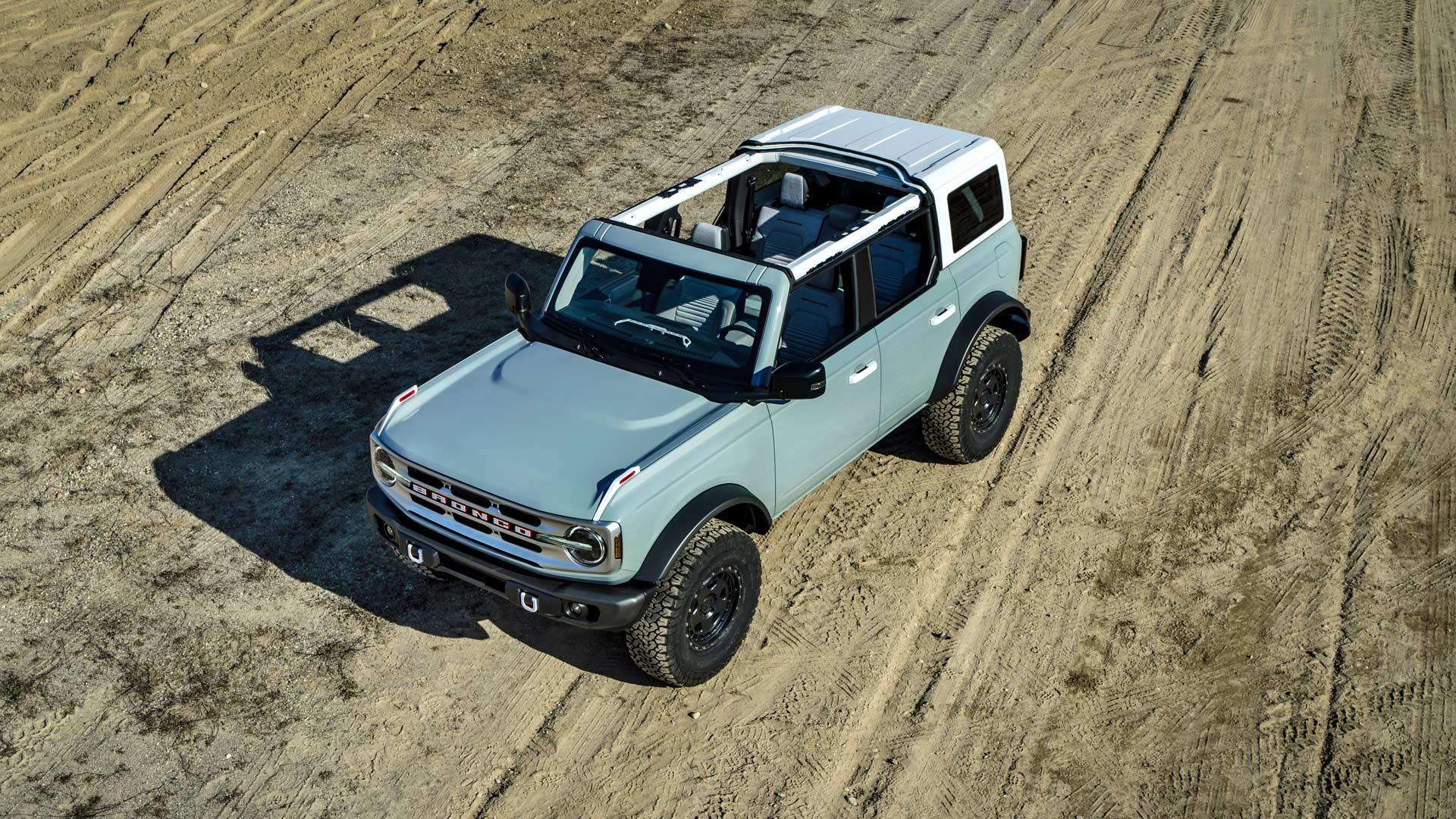
2021 Ford Bronco Four Door
© FordGiven the importance of the SUV market today, Ford did not want to limit the new Bronco to simply being a two-door model. Including the option of a four-door Bronco offers the same off-road experience, but with improved practicality.
Like the two-door model the four-door comes with a choice of engines. A 270 horsepower 2.3-liter EcoBoost four-cylinder is the base unit. Buyers can also opt for a 2.7-liter twin-turbocharged V-6, producing 310 horsepower.
Upholding tradition, the 2021 Bronco comes with four-wheel drive as standard. However, electronic locking differentials are thoroughly modern.
-
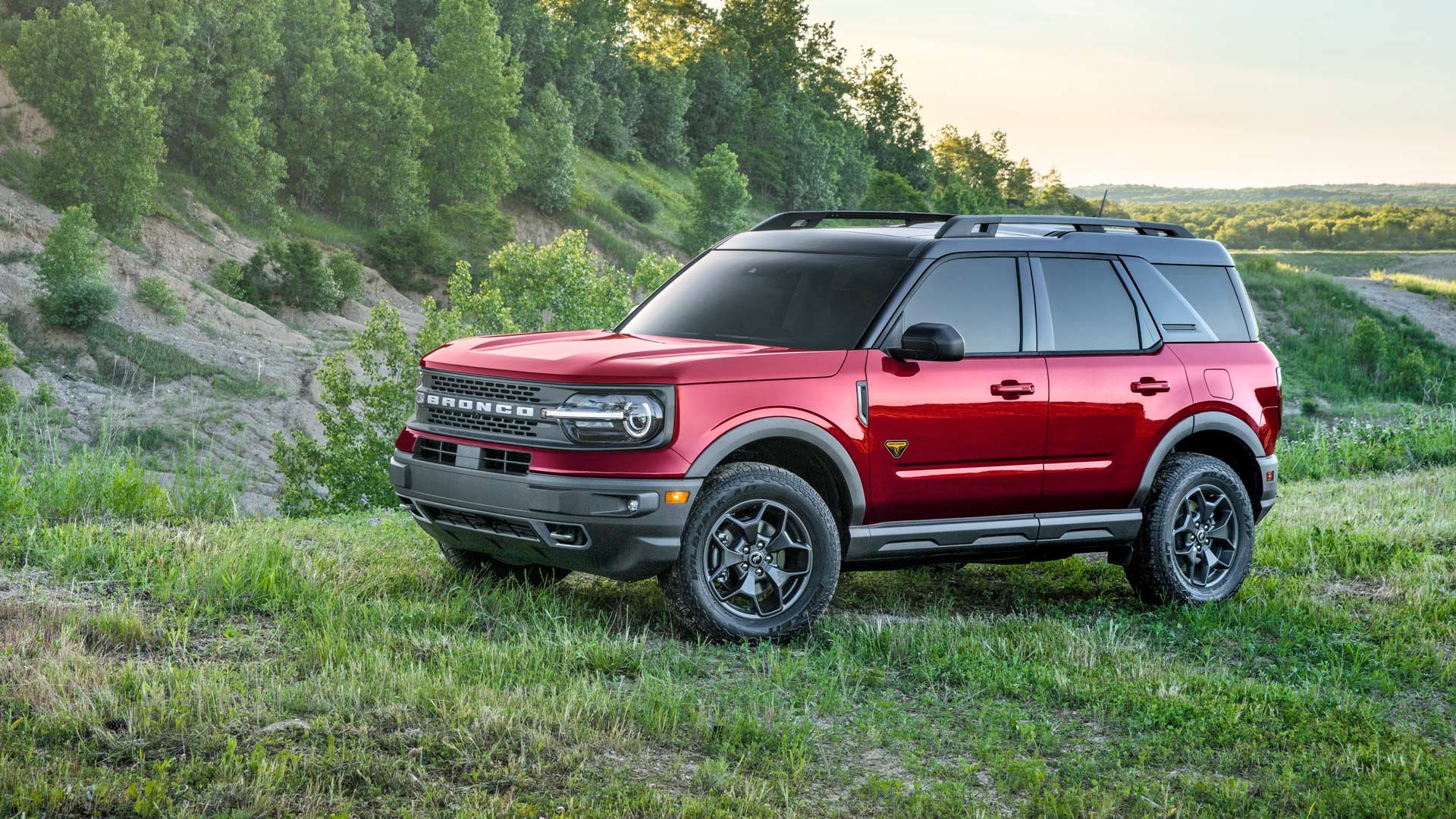
2021 Ford Bronco Sport
© FordSmaller than the other 2021 Bronco models, the Sport sits on a platform shared with the Ford Maverick and Lincoln Corsair. Acting as the crossover SUV in the Bronco range, the Sport is designed to be more comfortable and refined on the inside. Consider the Bronco Sport to be the modern equivalent of the 1984 Bronco II.
The Bronco Sport is still all-wheel drive, and comes with a choice of 1.5-liter EcoBoost three-cylinder or 2.0-liter EcoBoost four-cylinder engines. Independent suspension, and Trail Control technology, should ensure the Bronco Sport can still perform when the going gets tough.
-
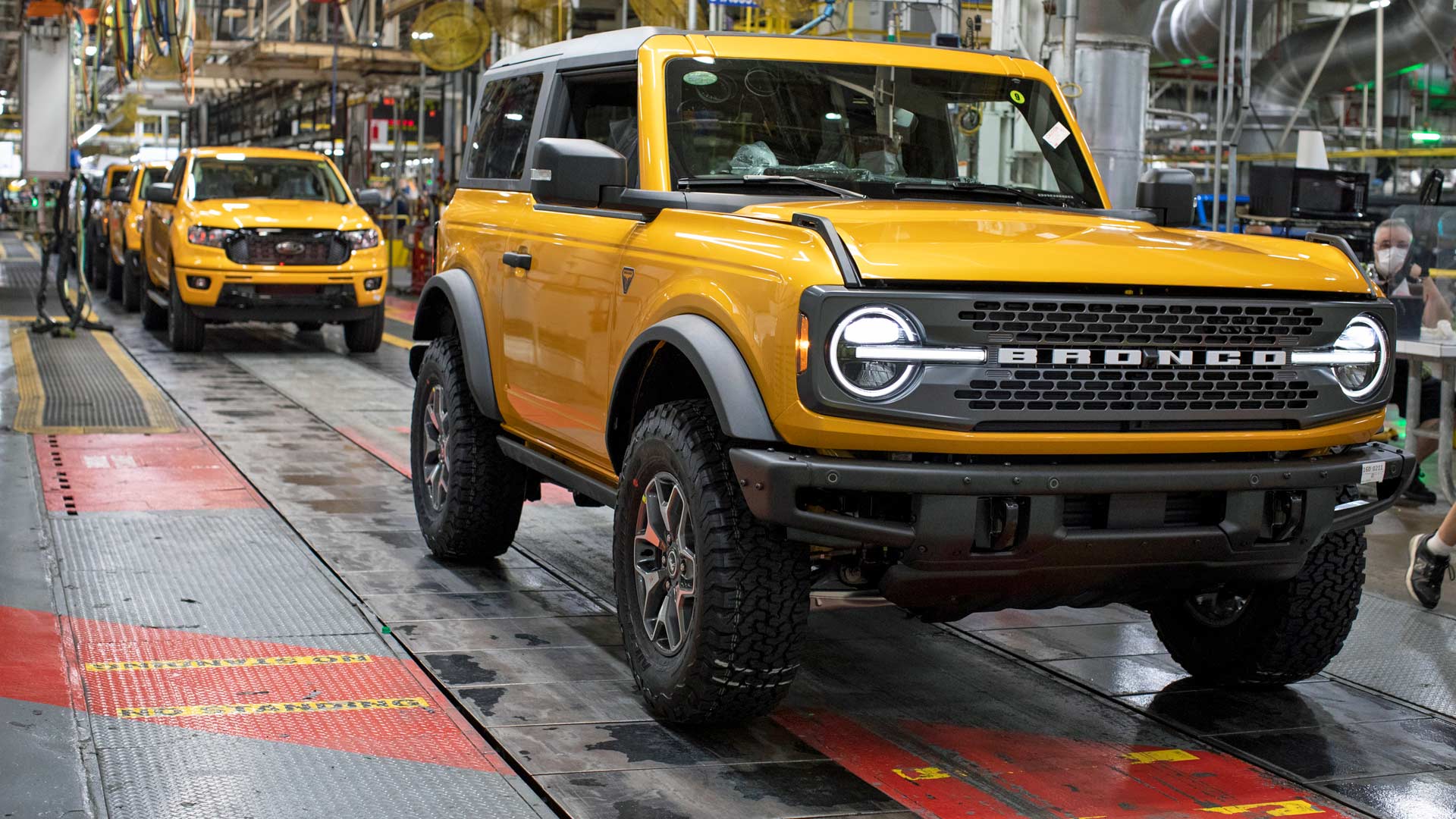
2021 Ford Bronco Production Starts
© FordThe big reveal of the all-new 2021 Bronco generated serious ‘Bronco Fever’ from Ford enthusiasts. Allowing fans to pre-order a new Bronco for just $100 resulted in an explosion of interest in the SUV.
Ford has invested $750 million in the Michigan Assembly Plant, creating 2,700 jobs. It means the new Bronco is being produced in the same place as the 1966 original.
With more than 125,000 orders placed for a new Bronco, meeting demand will keep the new employees busy well into the future. The first production models began rolling off the line in June 2021.
-
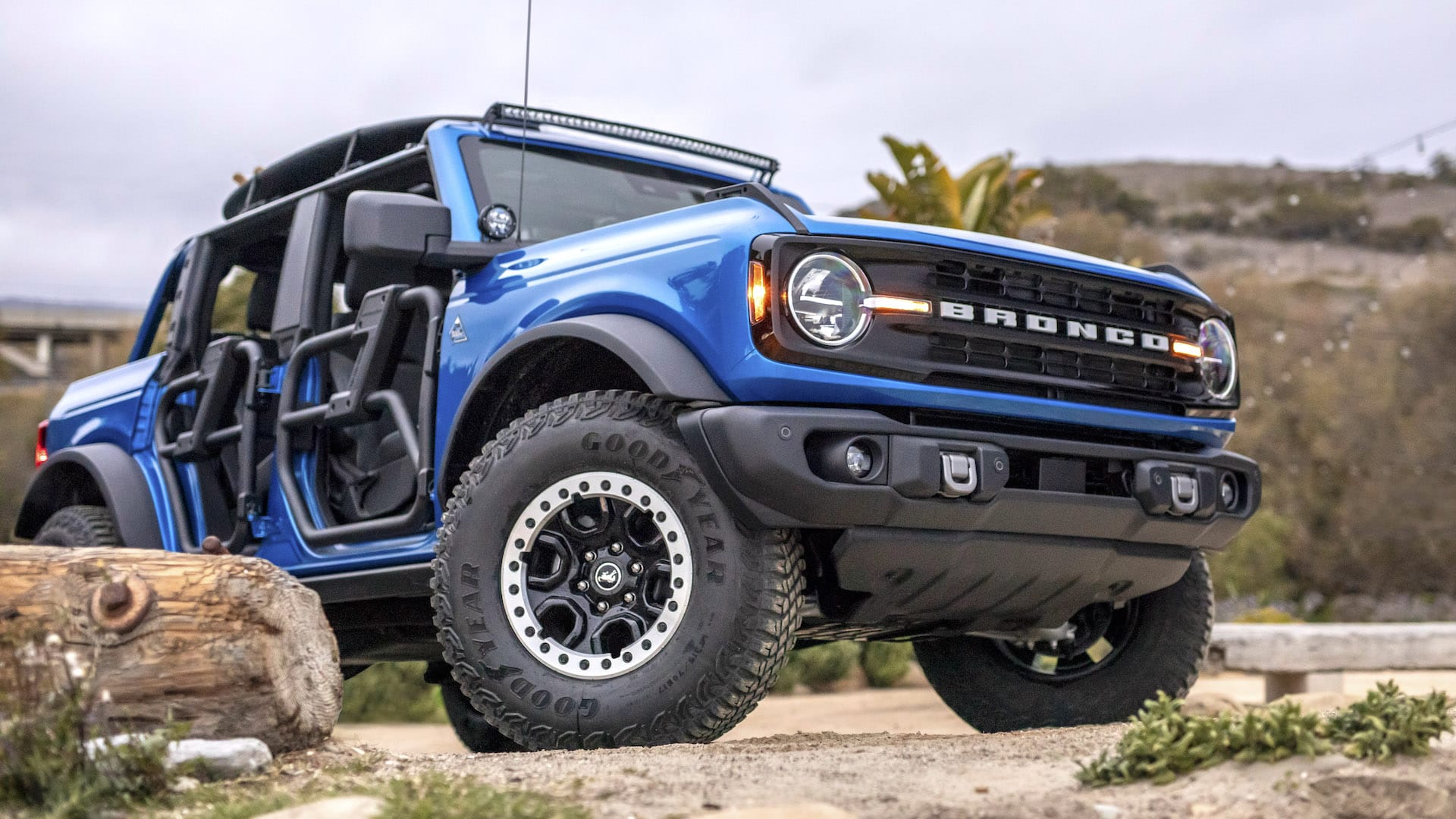
2021 Ford Bronco Riptide Project
© FordTo show off what is possible with factory-backed accessories, Ford created the Riptide Project version of the Bronco. Living the West Coast dream is the key theme, with Velocity Blue paintwork meant to evoke ideas of the ocean.
A factory Sasquatch package means 35-inch mud-terrain tires mounted to 17-inch factory wheels, electronic-locking front and rear axles, and Bilstein suspension.
Tubular doors have replaced the originals, with a Bimini mesh top, Yakima bike rack, and an LED light bar added. Two Almond surfboards complete the makeover.
-
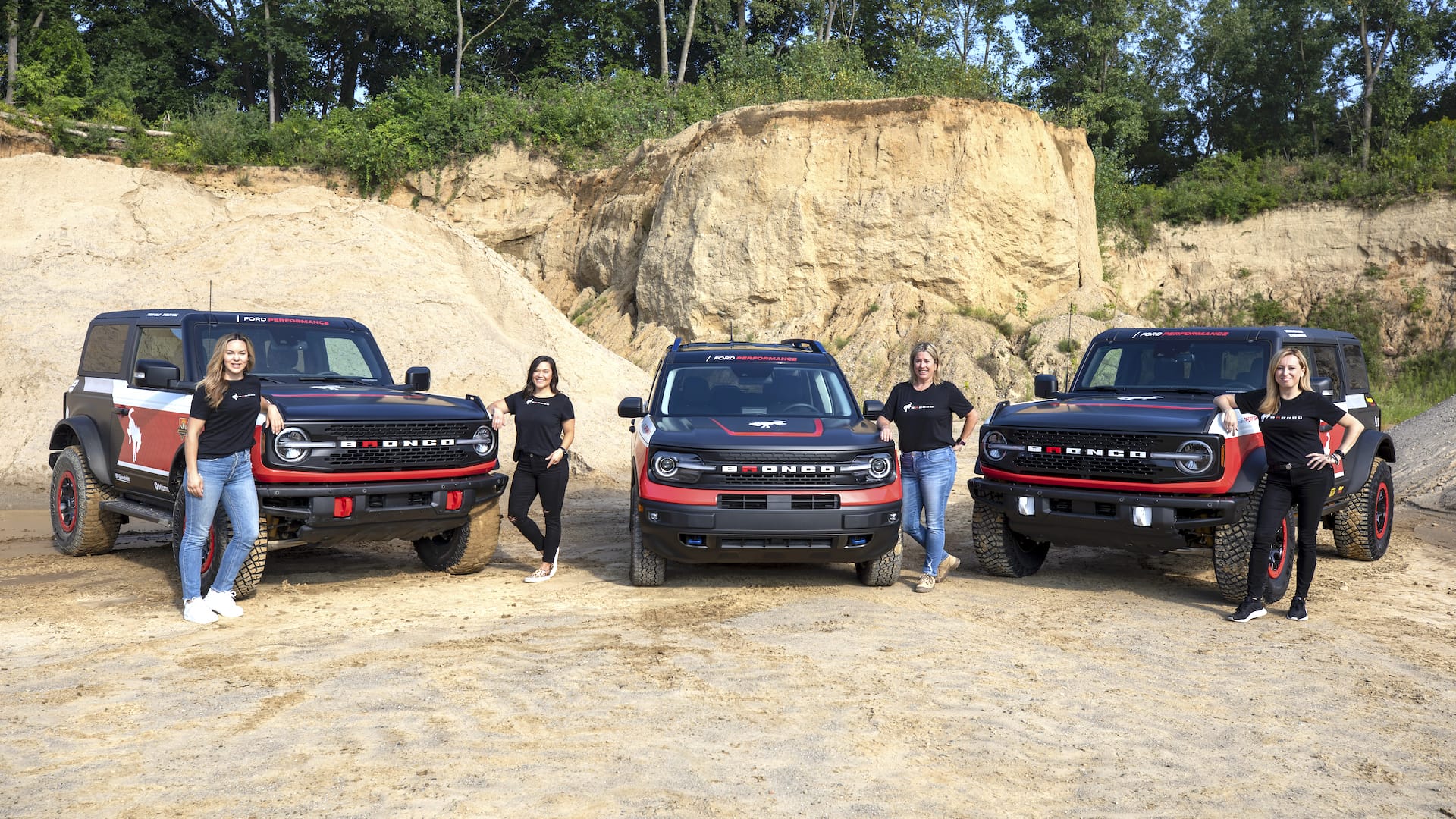
Ford Bronco returns to tackle 2021 Rebelle Rally
© FordFollowing a first-place finish in 2020, Ford plans to return with the Bronco to the Rebelle Rally again in 2021.
The all-woman event challenges teams to cross the harsh desert terrain of Nevada and California, with more than a week of competition action. For 2021, Ford has entered one of each model from the Bronco family. The Bronco Sport and Bronco four-door will be in Badlands specification, with the two-door a Wildtrak version.
The 2021 event begins on October 8, and finishes at Imperial Sand Dunes in California on October 16.
-
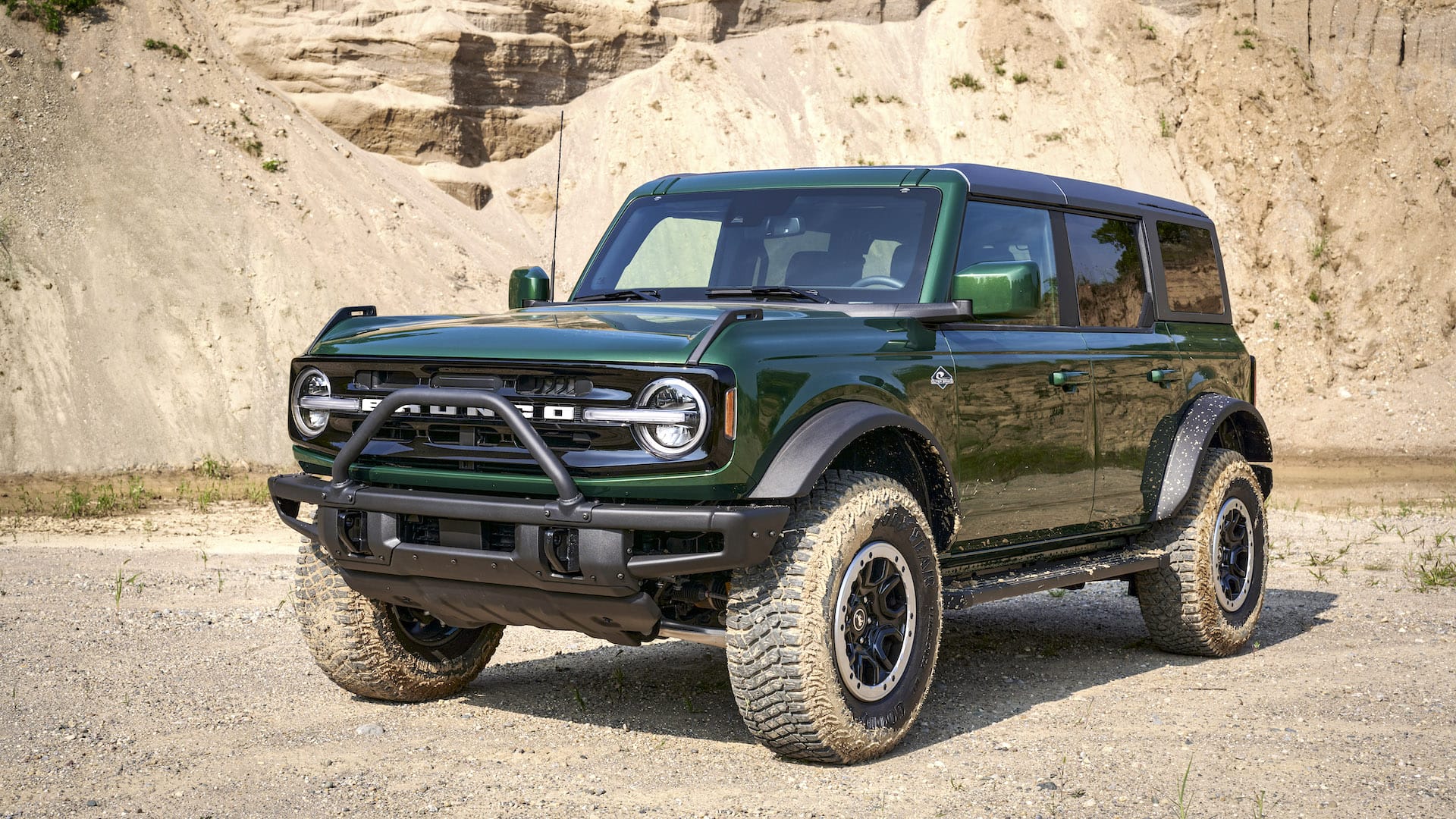
2022 Ford Bronco
© FordWith the 2021-model year Bronco being so late to enter production, Ford has kept updates for the 2022 version relatively subtle.
The biggest change is the announcement of Eruption Green Metallic paint. Ford has described it as a modern interpretation of the Mallard Green color, which was used on the first-generation Bronco.
Demand from fans led Ford to release a green Bronco option, with Hot Pepper Red also added to the options list for 2022.
-
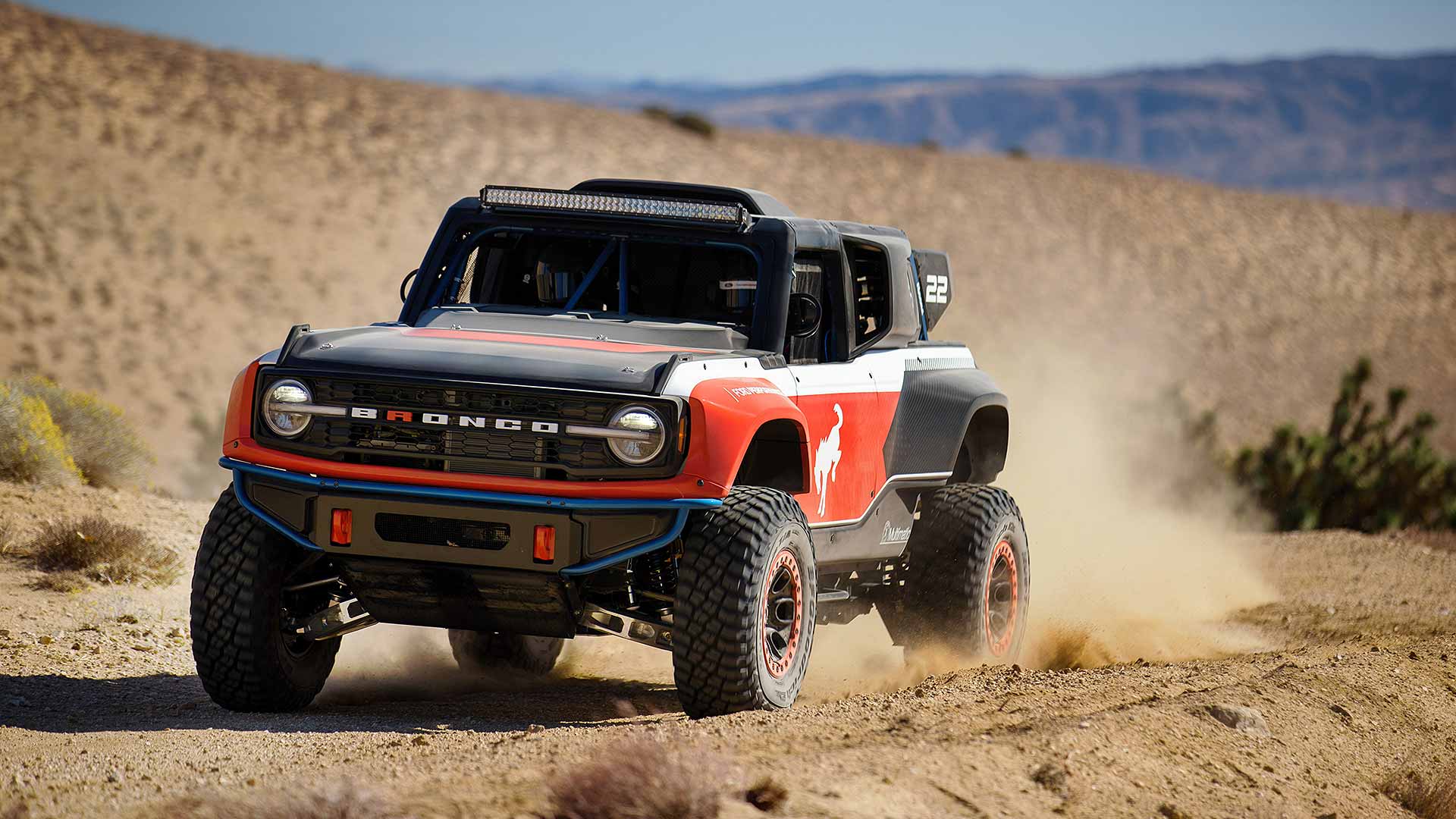
2023 Ford Bronco DR Prototype
© FordProving just how serious Ford is about the new Bronco as an off-roader, the DR Prototype aims to be a turn-key racer. Based upon the production four-door Bronco, the DR model will be built to tackle the Baja 1000 event.
It becomes the first version of the reborn Bronco to be powered by a V-8 engine, boasting a 5.0-liter Coyote engine. Although exact outputs will be confirmed nearer to launch, Ford expects it to be at least 400 horsepower.
A ten-speed automatic transmission will be standard, along with a transfer case from the F-150 pickup. Positional Selective DSSV Dampers will be added to the suspension, along with custom billet parts from Multimatic.
-
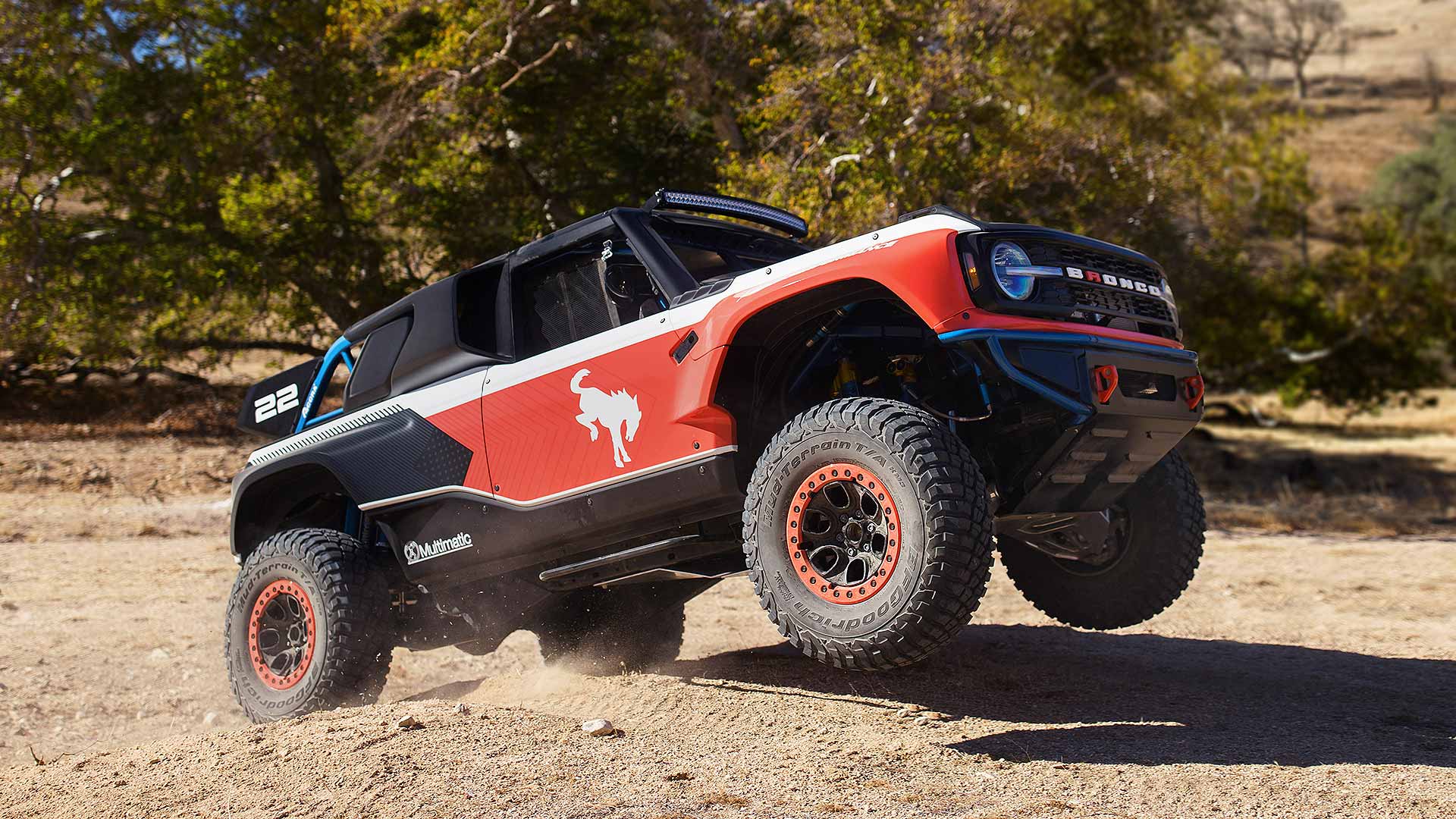
2023 Ford Bronco DR Prototype
© FordFiberglass bodywork will be wrapped around a Multimatic roll cage, while the interior is designed to seat two. The cabin has been stripped of all unnecessary items, with a Motec dashboard and extra grab handles installed.
Ford plans to offer the first 50 units of the Bronco DR in late 2022, and will enter it into the 2022 Baja 1000. Buyers should expect to pay in the region of $200,000 for the ultimate new Bronco.
-
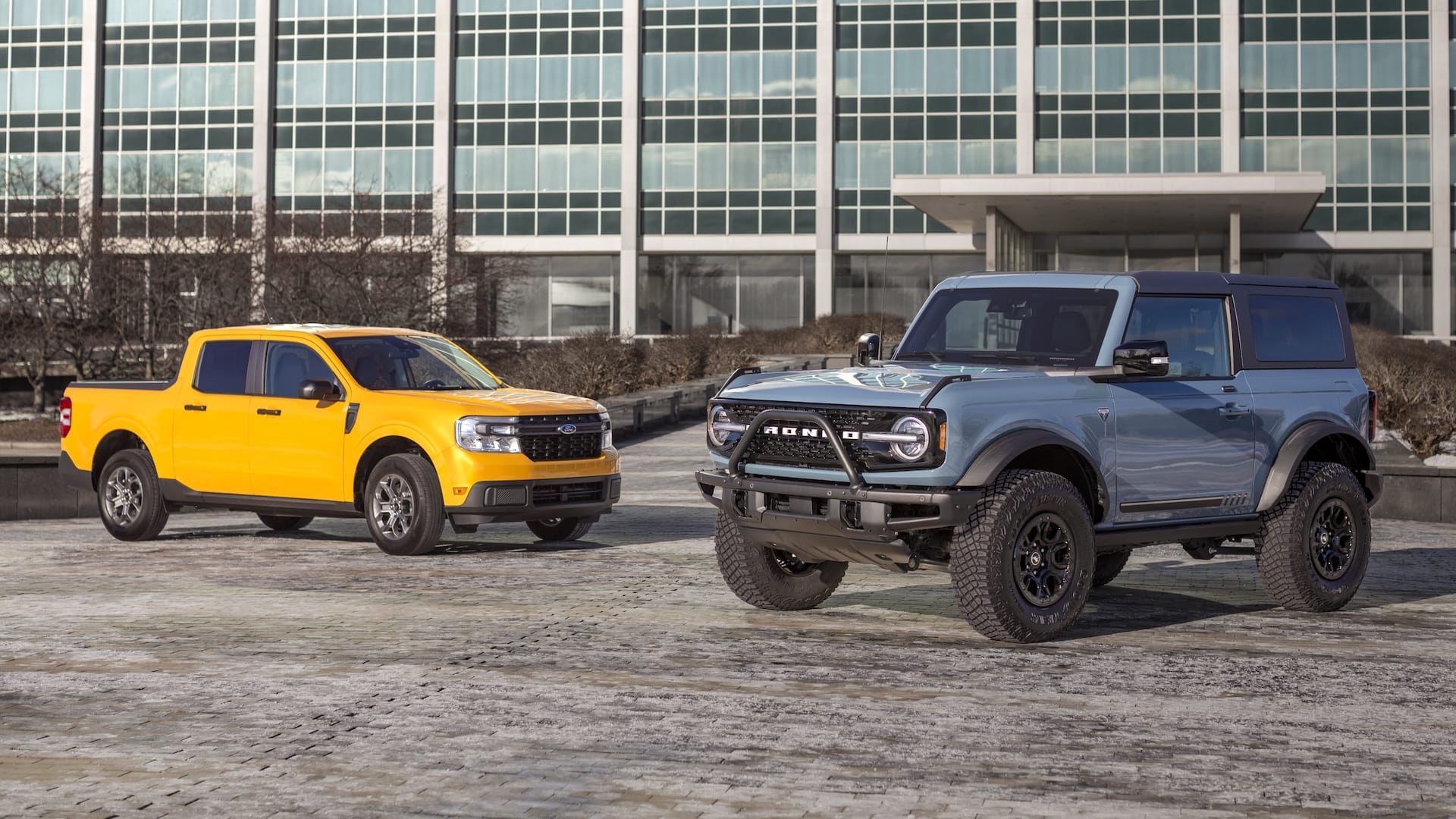
Ford Bronco wins 2022 Utility Vehicle of the Year
© FordProving the Bronco appeals to more than just Ford fans, it has also collected a major award. The independent judges of the North American Car, Utility and Truck of the Year Awards picked the Bronco as their 2022 Utility Vehicle of the Year.
It becomes the 12th trophy won by the new Bronco. Ford enjoyed double success at the North American Car, Utility and Truck of the Year Awards, with the Maverick pickup taking the 2022 Truck of the Year title.
-
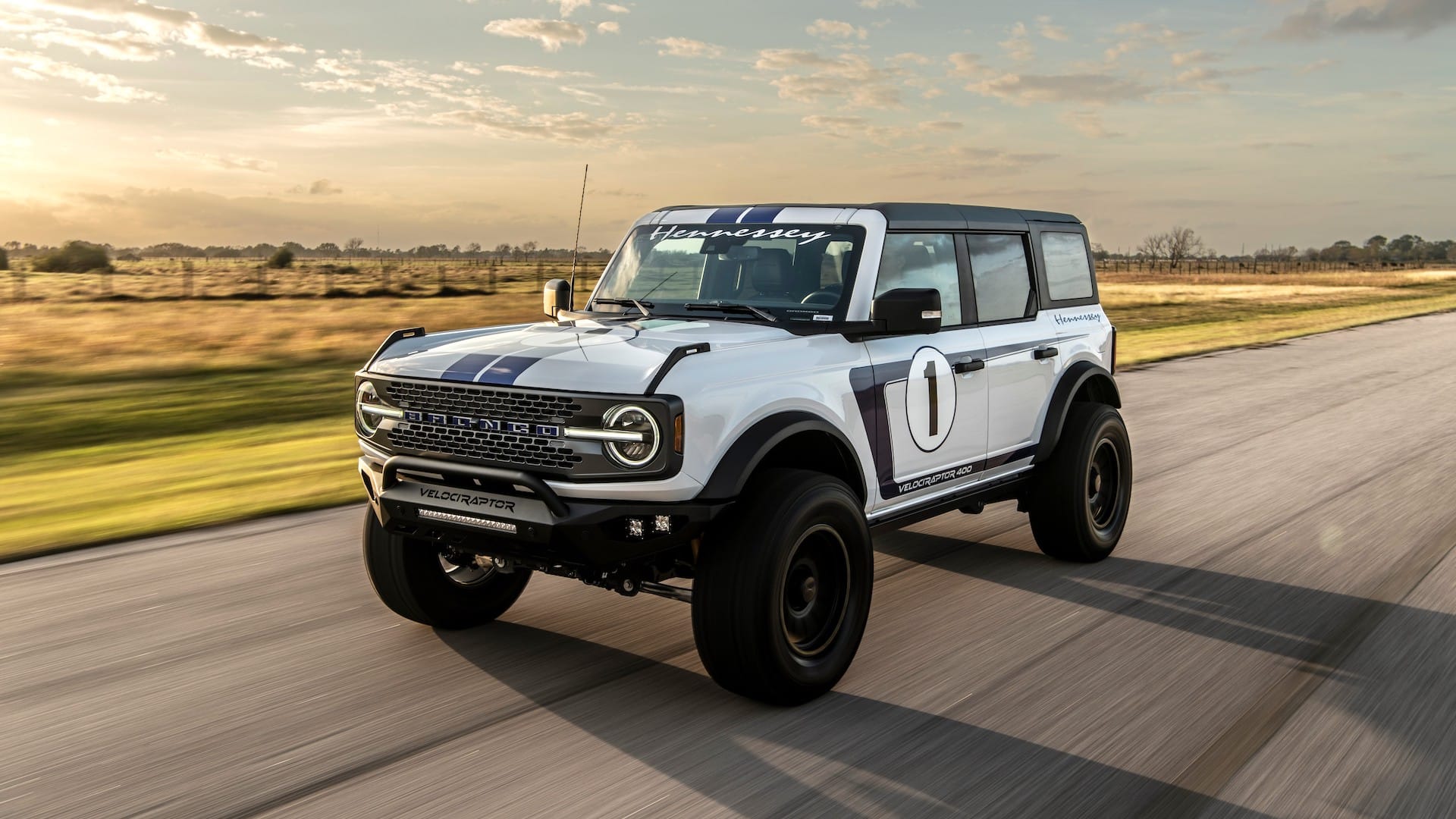
2022 Hennessey VelociRaptor 400 Bronco
© HennesseyTexas tuner Hennessey beat Ford to launching a performance version of the Bronco by a matter of days. The company unveiled its modified VelociRaptor 400 Bronco at the 2022 Barrett-Jackson auction in Scottsdale.
Using an upgraded version of the 2.7-liter EcoBoost V-6, Hennessey has tweaked the engine to deliver 411 horsepower and 603 lb-ft of torque. This allows the VelociRaptor to accelerate from 0-60 mph in just 4.9 seconds.
Production is limited to 200 units each year, and buyers can choose from an endless array of optional extras.
-
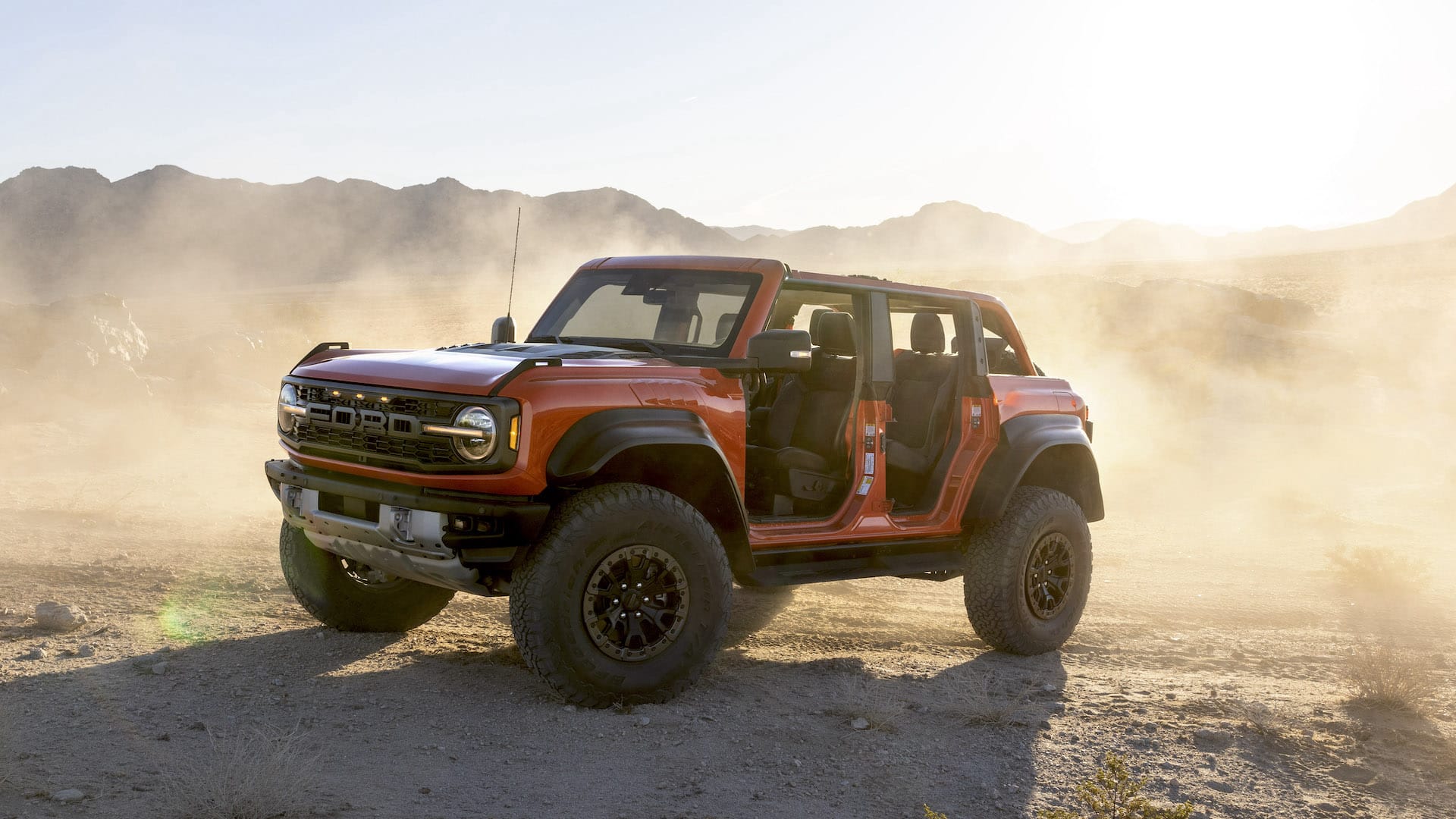
2022 Ford Bronco Raptor
© FordUsing the same name as Ford’s highly successful series of off-road pickup trucks, the Bronco Raptor was always going to mean business. Said to be inspired by hardcore Ultra4 racers, the Raptor is designed to crawl across rocks and conquer desert dunes.
New axles taken from the Bronco DR racer are used, combined with Fox components for the High-Performance Off-Road Stability Suspension system. Star of the show is a bespoke 400 horsepower version of Ford’s 3.0-liter EcoBoost V-6. A 10-speed automatic transmission is standard, along with a performance exhaust that offers four selectable modes.
-
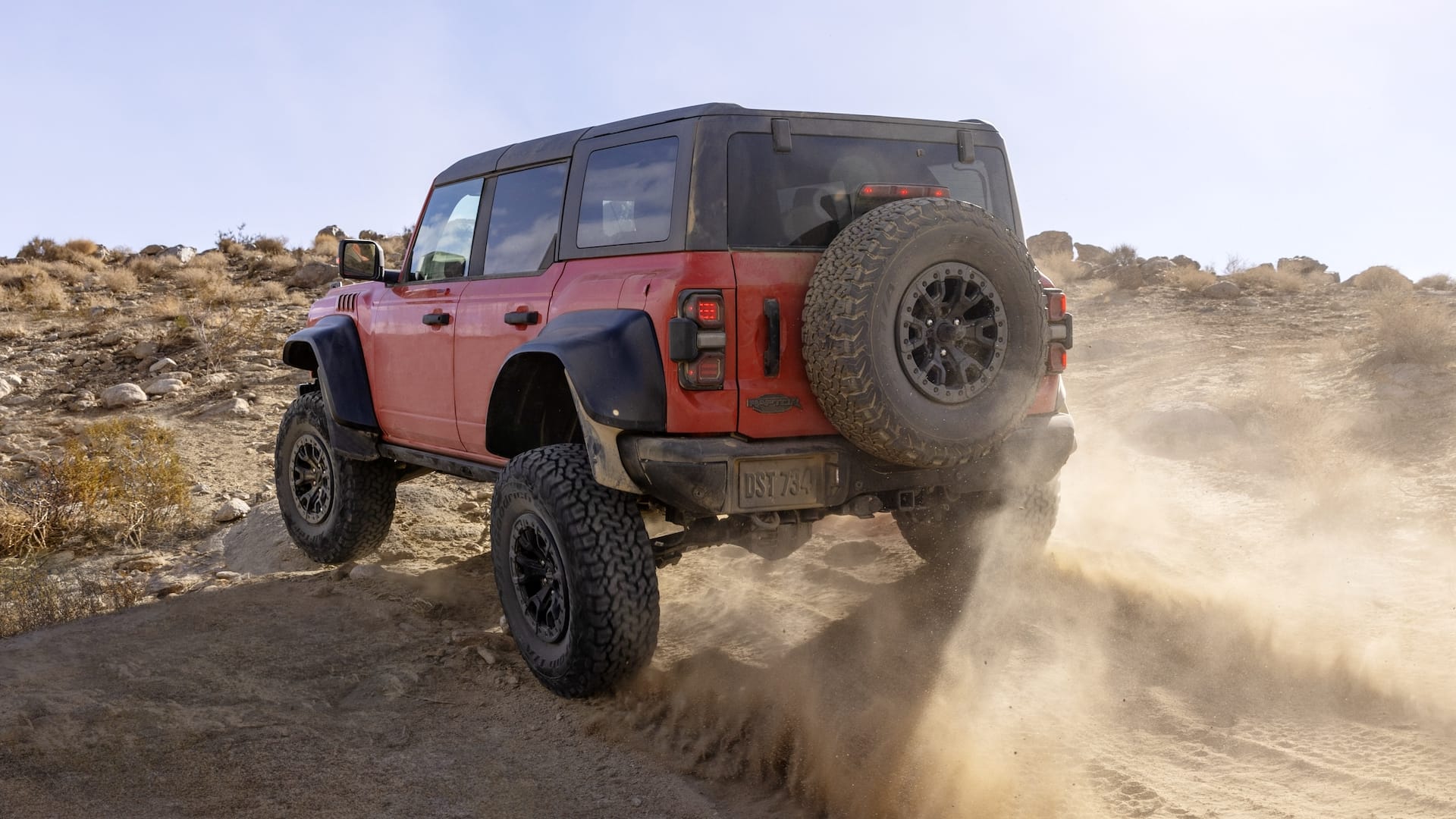
2022 Ford Bronco Raptor
© FordAlong with enhancements under the skin, Ford has made the Bronco Raptor look more aggressive than the regular SUV. A two-piece front grille features bespoke LED headlights, with a heavy-duty Ford Performance modular steel bumper below.
Massive fender flares cover 17-inch beadlock wheels and add 9.8 inches to the overall width of the Bronco. Skid plates protect the drivetrain underneath, and Ford has reinforced the B-pillar and C-pillar for extra chassis strength.
-
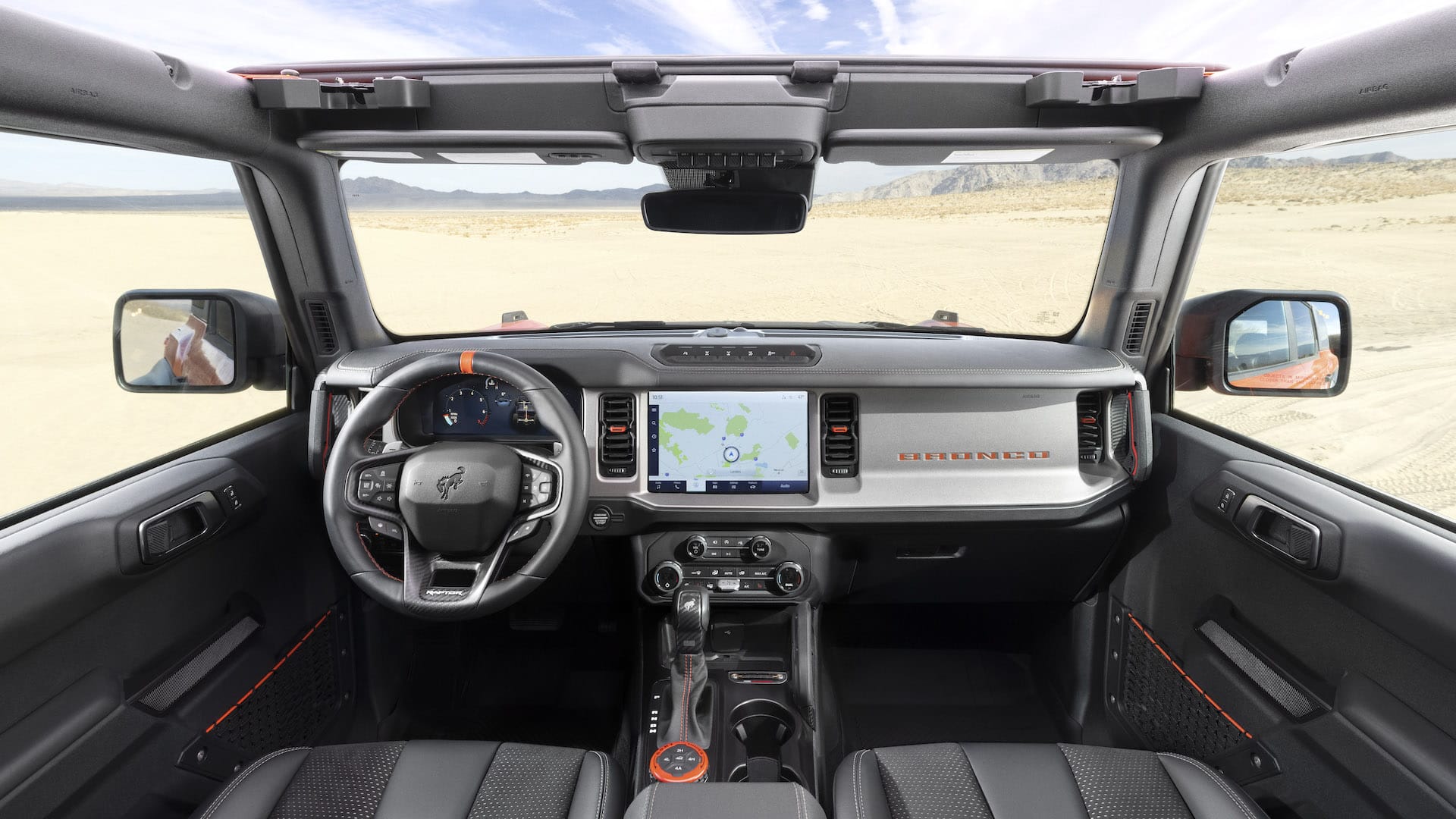
2022 Ford Bronco Raptor Interior
© FordBronco Raptor buyers can pick from 10 different exterior colors, including Ford Performance-exclusive Code Orange paint. As with Raptor pickups, a graphics package will also be available.
Inside, Ford fits the Bronco Raptor with Black Onyx marine-grade vinyl sports seats and rubberized flooring. Carbon fiber trim is used for the grab handles, steering wheel bezel and gear shifter, with orange detailing throughout the cabin. Ford fans can place orders from March 2022, with first deliveries expected in the summer.
-

2021 Ford Bronco Pope Francis Center First Edition
© FordAs part of the annual Barrett-Jackson Scottsdale event, for 2022 Ford auctioned a bespoke Bronco for charity.
Based upon a First Edition mode, the Bronco is finished in classic Wimbledon White paint, and features heritage-style white wheels. Rapid Red stripes, and a silver front grille, are intended to pay homage to the original Bronco of 1966.
Crossing the auction block, the unique Bronco raised an incredible $500,000 for the Pope Francis Center in Detroit.
-
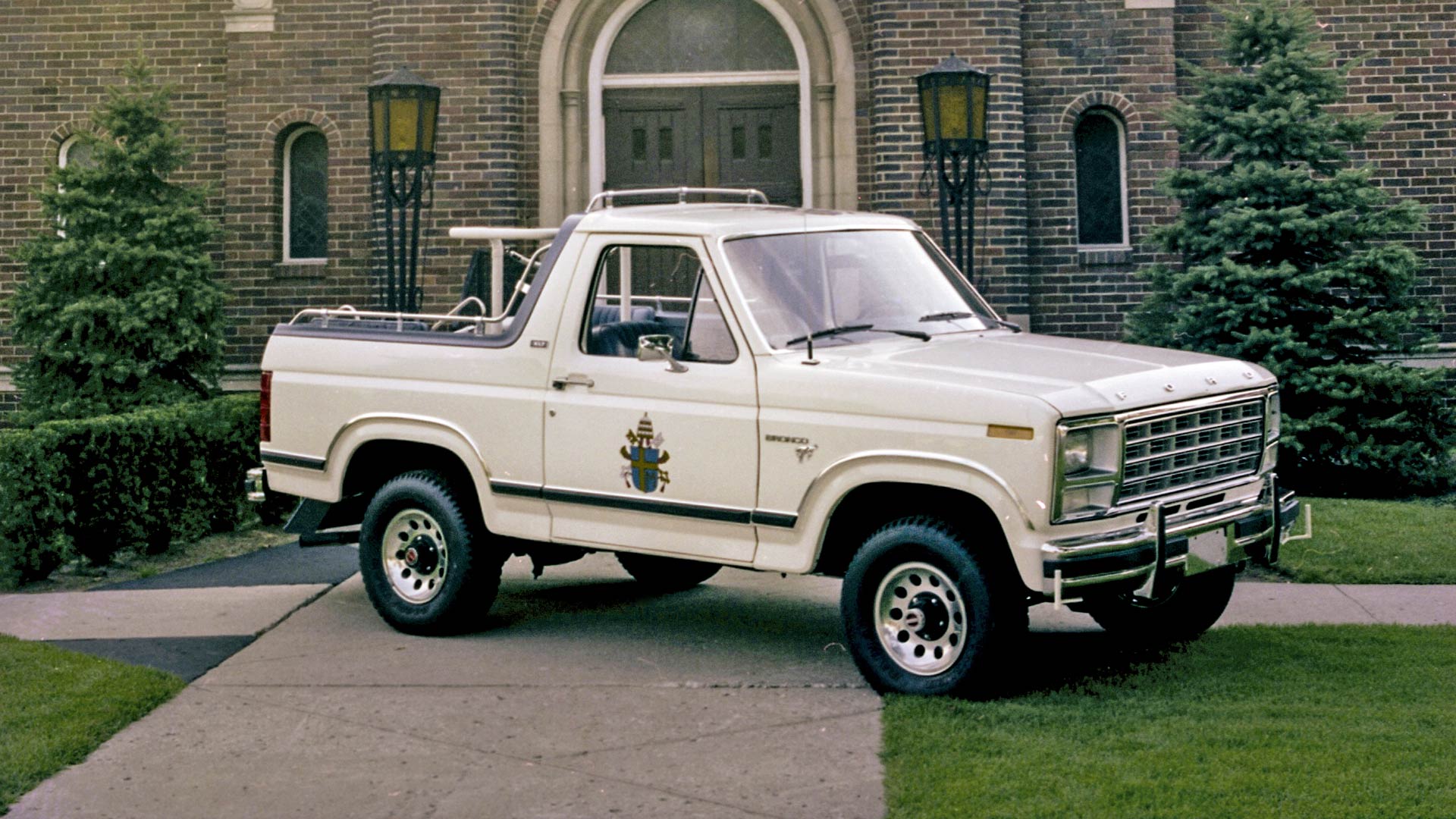
1980 Ford Bronco Popemobile
© FordInspiration for the Pope Francis Center First Edition was also taken from the time a Bronco served as an official Popemobile. The heavily modified version of the Bronco was used by Pope John Paul II as part of his trip to the United States in 1979.
Painted in Wimbledon White, the Popemobile included an open-air rear compartment, complete with access steps. Following the visit, Ford gave ownership of the Bronco to the U.S. Secret Service.
-
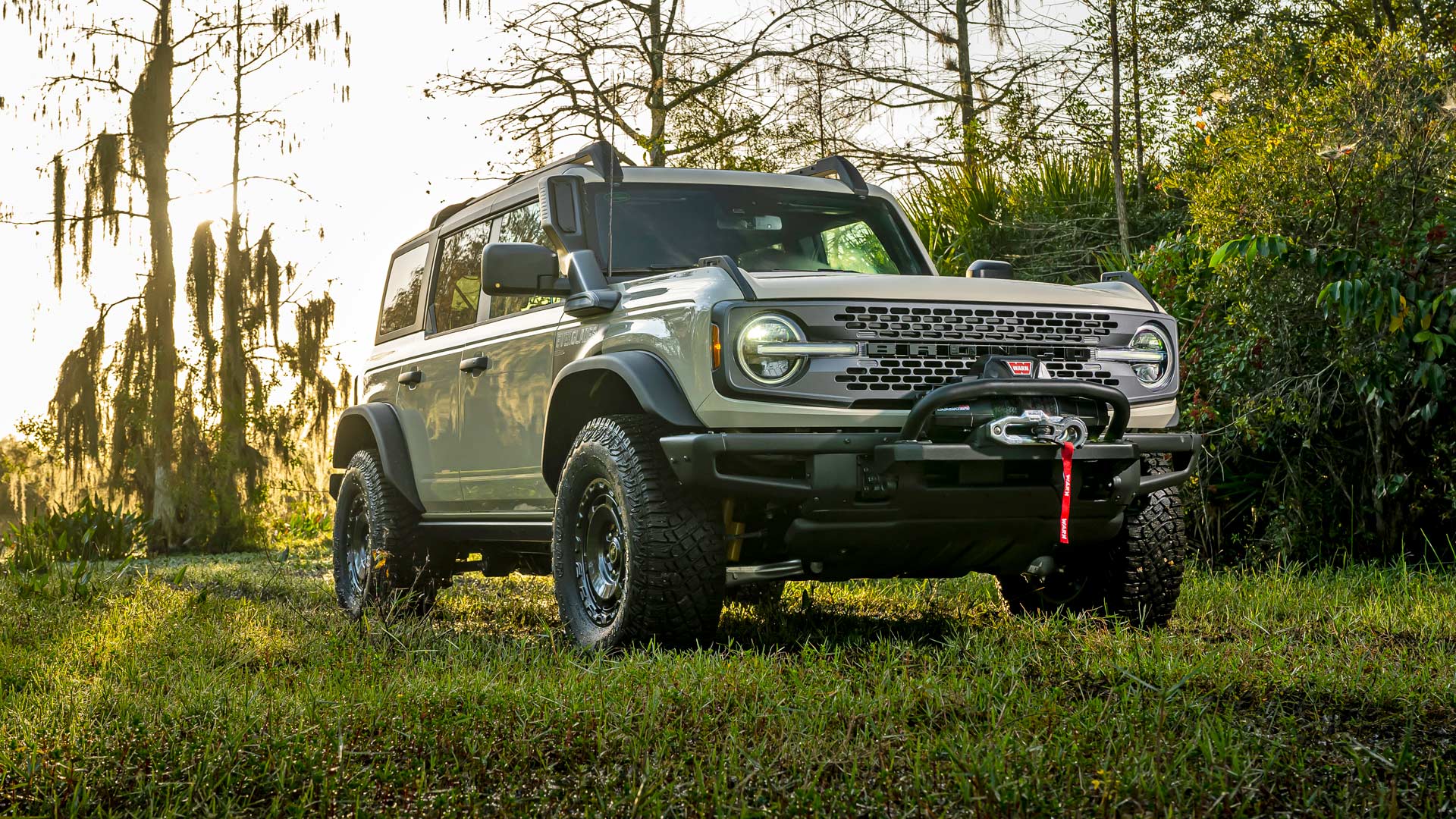
2023 Ford Bronco Everglades
© FordAlthough the standard Bronco is already capable off-road, Ford has created a special edition with even greater ability in the dirt. Branded the ‘Everglades’, it adds even more equipment to the comprehensive Sasquatch Package.
This includes a Ford-designed air intake snorkel, with switchable plates to change the direction air is taken from. A Ford Performance heavy-duty front bumper houses a Zeon 10-S Warn winch, capable of pulling up to 10,000 lb.
New raised vents for the front and rear axles, transfer case, and transmission allow for improved fording abilities. The Everglades is able to venture into water up to 36.4 inches deep.
-
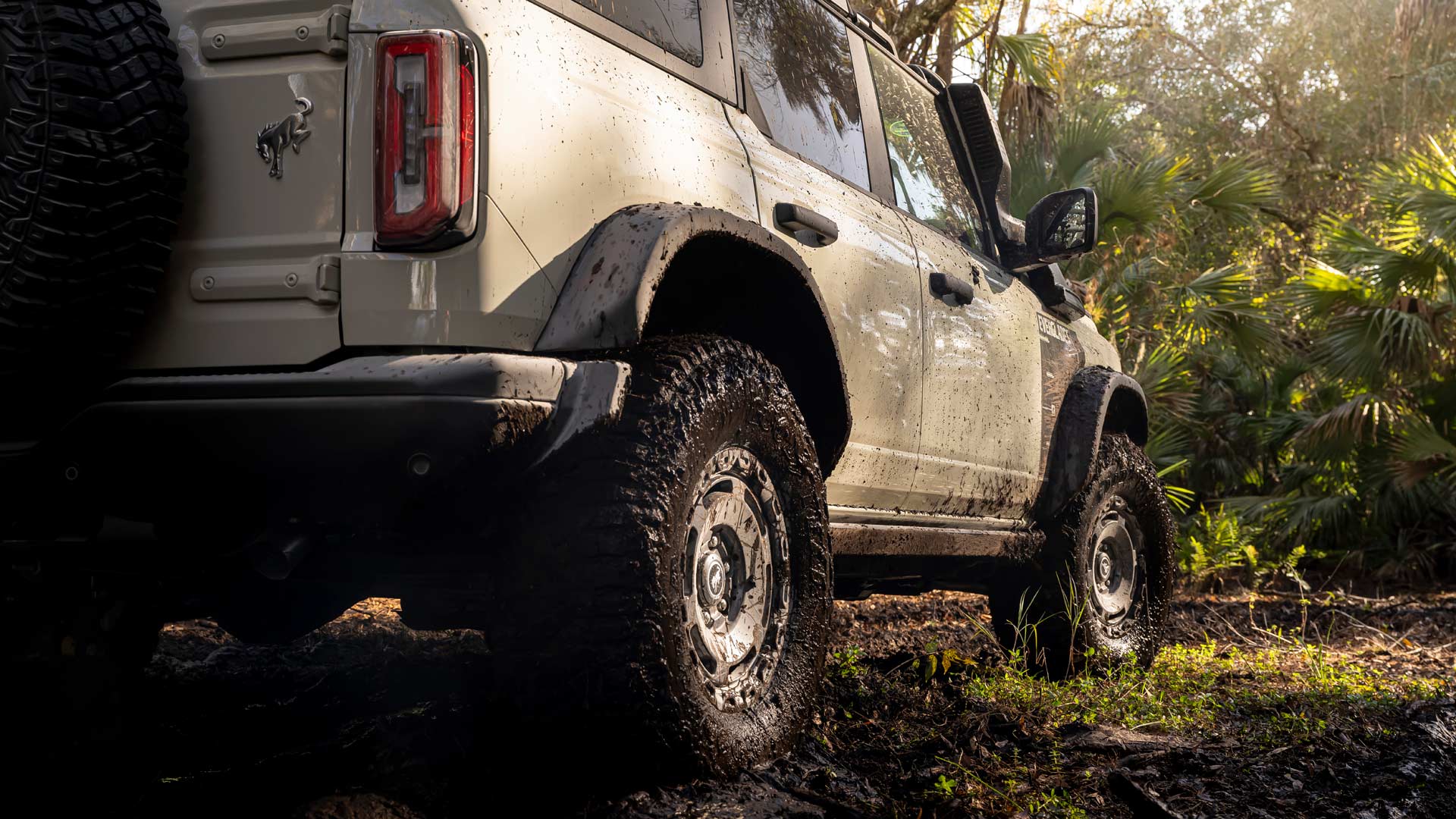
2023 Ford Bronco Everglades
© FordDistinguishing the Everglades from other Broncos is a unique Carbonized Gray grille, with gloss black Bronco lettering. The Everglades also wears special squared-off wheel arches, with wide fender flares as standard.
Inside, Ford fits marine-grade vinyl for the seats, with a rubberized washout flooring.
Finally, Everglades decals are applied to the front fenders. Their design is said to mimic the topography of the famed wetland region.